Category: History
Exhibition at the MAXXI, Rome, 25 Apr — 16 Sep 2018
The exhibition Zevi’s Architects. History and Counter-history of Italian Architecture is based on the idea of uniting the figure of Bruno Zevi with a significant work designed by an architect or group of architects whom the great historian and critic supported and appreciated throughout his career. The exhibition, staged in collaboration with the Fondazione Bruno Zevi and curated by Pippo Ciorra and Jean-Louis Cohen (it will be at the MAXXI until 16 September), celebrates the centenary of the birth of one of the most eccentric and multifaceted personalities of the 20th century, a man who was able to combine work as a historian, teacher, architect and designer with the role of politician as well as radio and TV broadcaster. In the exhibition historical and biographical material is interwoven with the drawings, photos and models. The account of his life begins in the pre-war years when he attended the Liceo Classico Tasso in Rome, where he took part in the Littoriali, the artistic and cultural contests organized by the Fascist regime, and joined the leftist group headed by Ruggero Zangrandi where the difficult art of criticizing the regime apparently from within was being honed. After this came years of exile as a result of the racial laws, a university education at Harvard and his return, with the foundation of the Association for Organic Architecture which united a renewal of architecture with the needs of reconstruction.
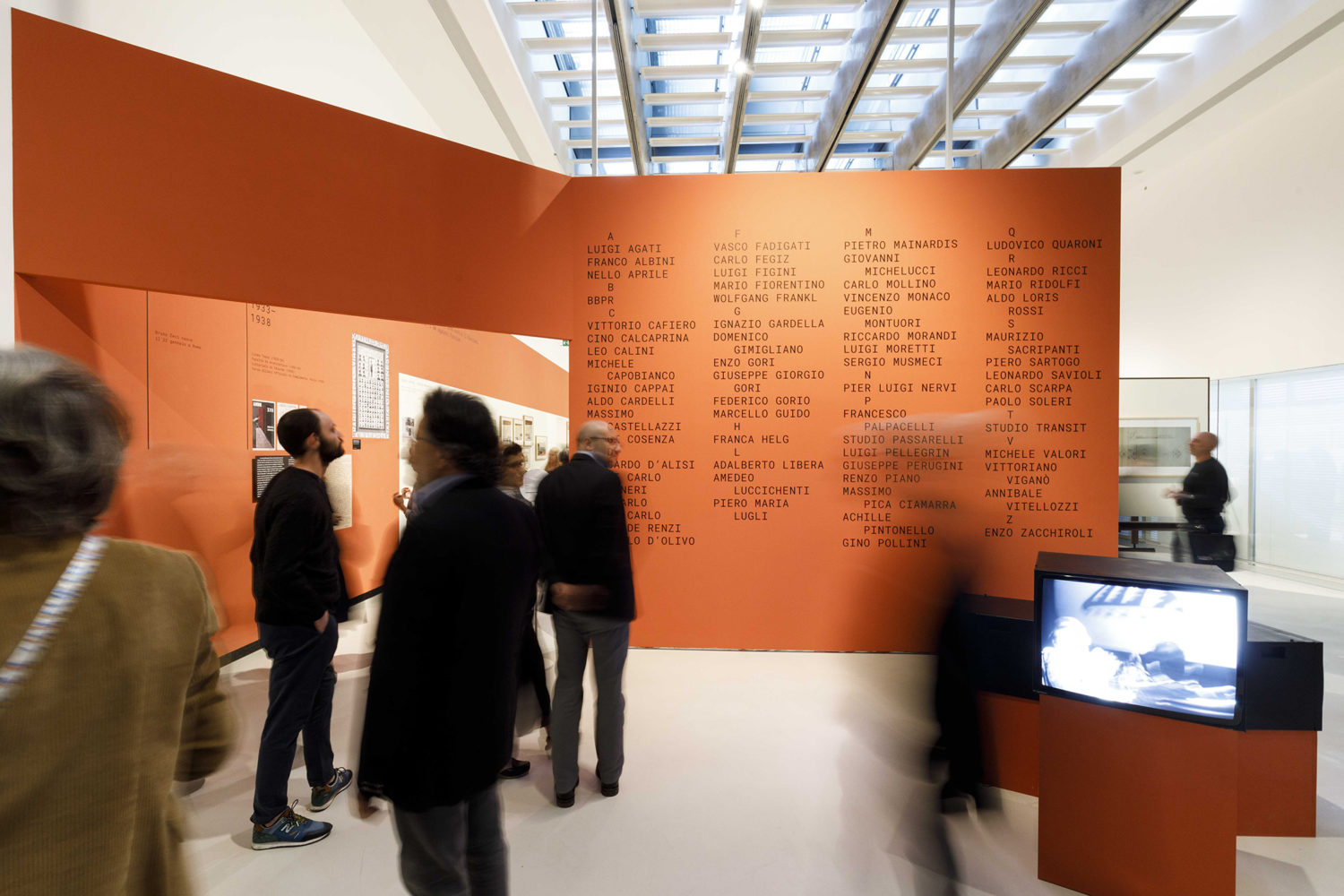
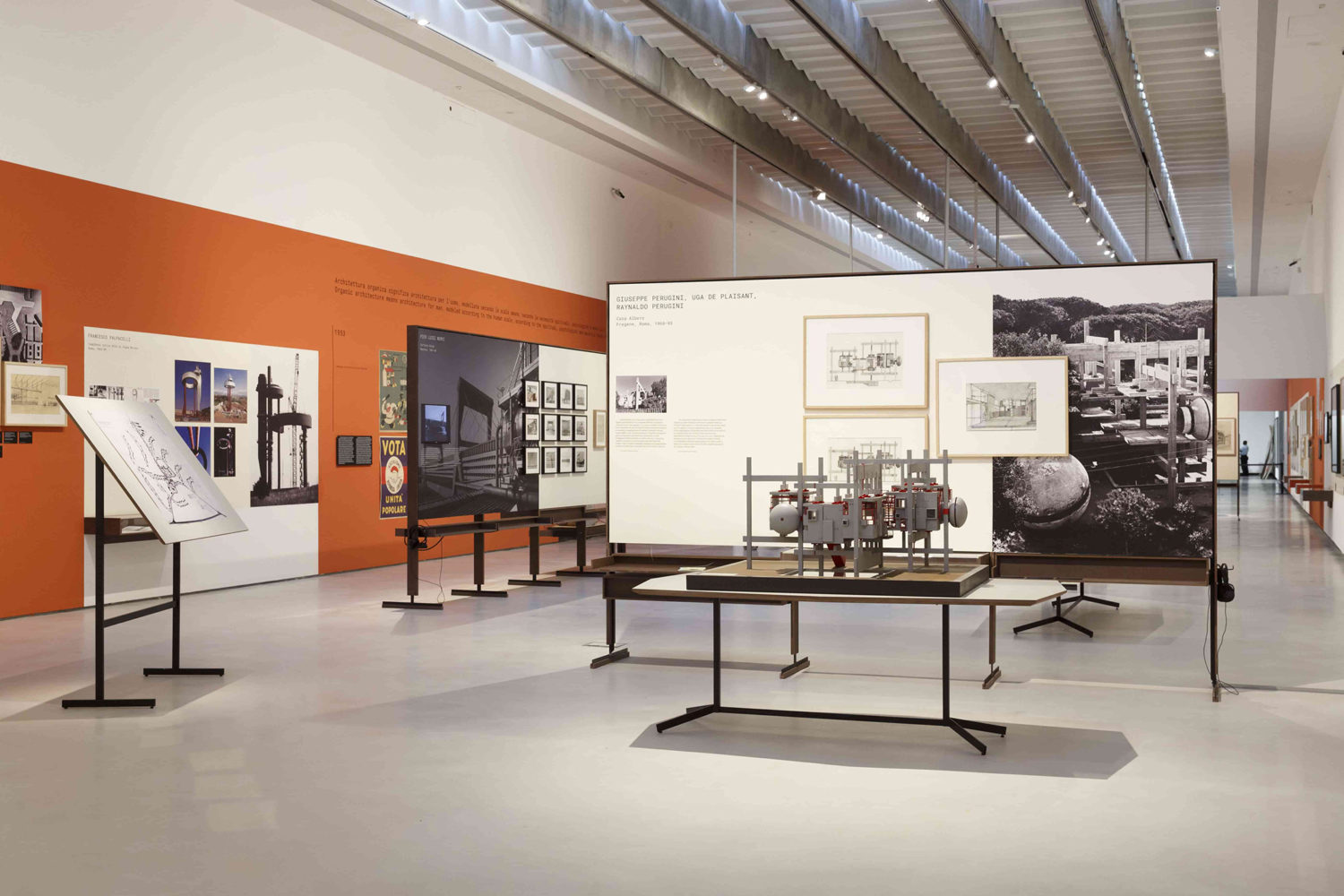
Exhibition book:
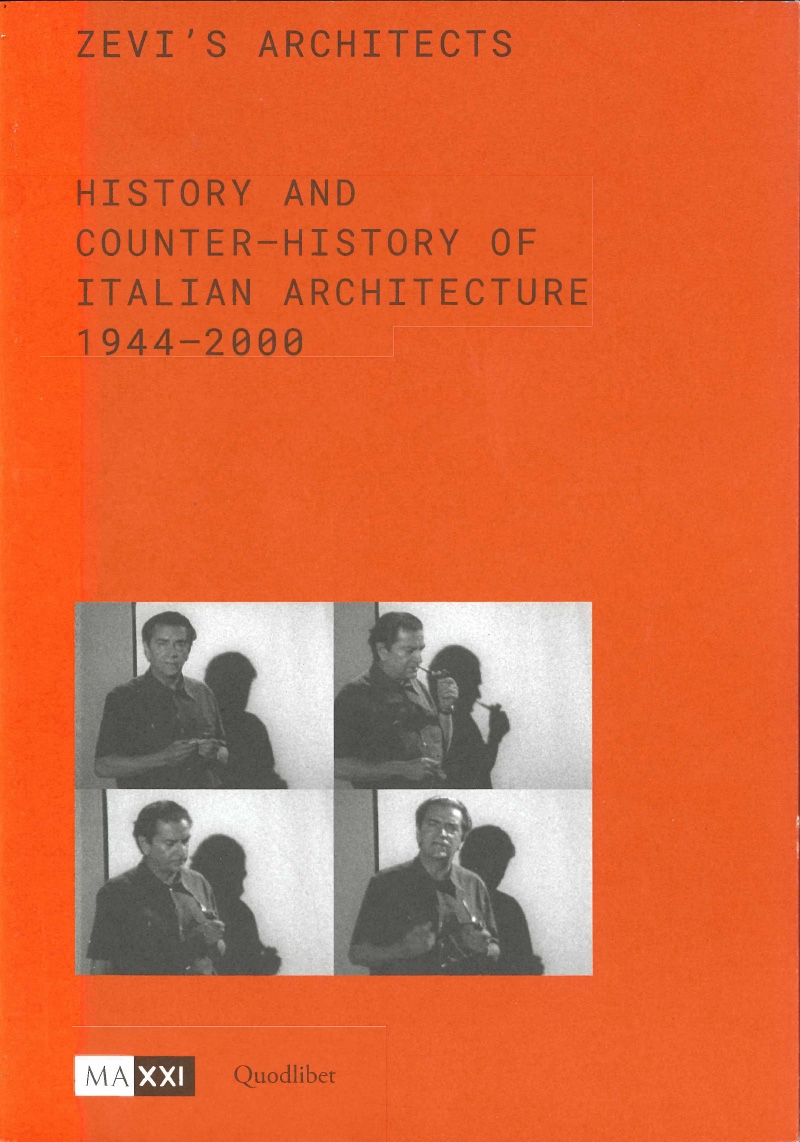
Zevi’s Architects – History and Counter-History of Italian Architecture 1944-2000
List of architects included in the exhibition:
Luigi Agati
Franco Albini
Nello Aprile
BBPR
Vittoria Cafiero
Cino Calcaprina
Leo Calino
Michele Capobianco
Iginio Cappai
Aldo Cardelli
Massio Castellazzi
Luigi Cosenza
Riccardo D’Alisi
Luigi Carlo Daneri
Mario de Renzi
Marcello D’Olivo
VascoFadigatti
Carlo Fegiz
Mario Fiorentino
Wolfgang Frankl
Ignazio Gerdella
Domenci Gimigliano
Enzo Gori
Giuseppe Giorgio Gori
Federico Gordi
Marcello Guido
Franc Helg
Alberto Libera
Ameneo Luccichenti
Pietro Mainardis
Giovanni Michelucci
Carlo Mollino
Vincencio Monaco
Eugenio Montuaori
Riccardo Morandi
Sergio Musmeci
Pier Luigi Nervi
Francesco Palpacelli
Renzo Piano
Massimo Pica Ciamarra
Achille Pintonello
Gino Pollini
Ludovico Quaroni
Leonardo Ricci
Mario Ridolfi
Aldo Loris Rossi
Maurizio Sacripanti
Pietro Sartogo
Carlo Scarpa
Paolo Soleri
Studion Transit
Michele Valori
Vittorano Vigano
Anniblae Vitellozzi
Enzo Zacchiroli
MAXXI Rome – Link to exhibition
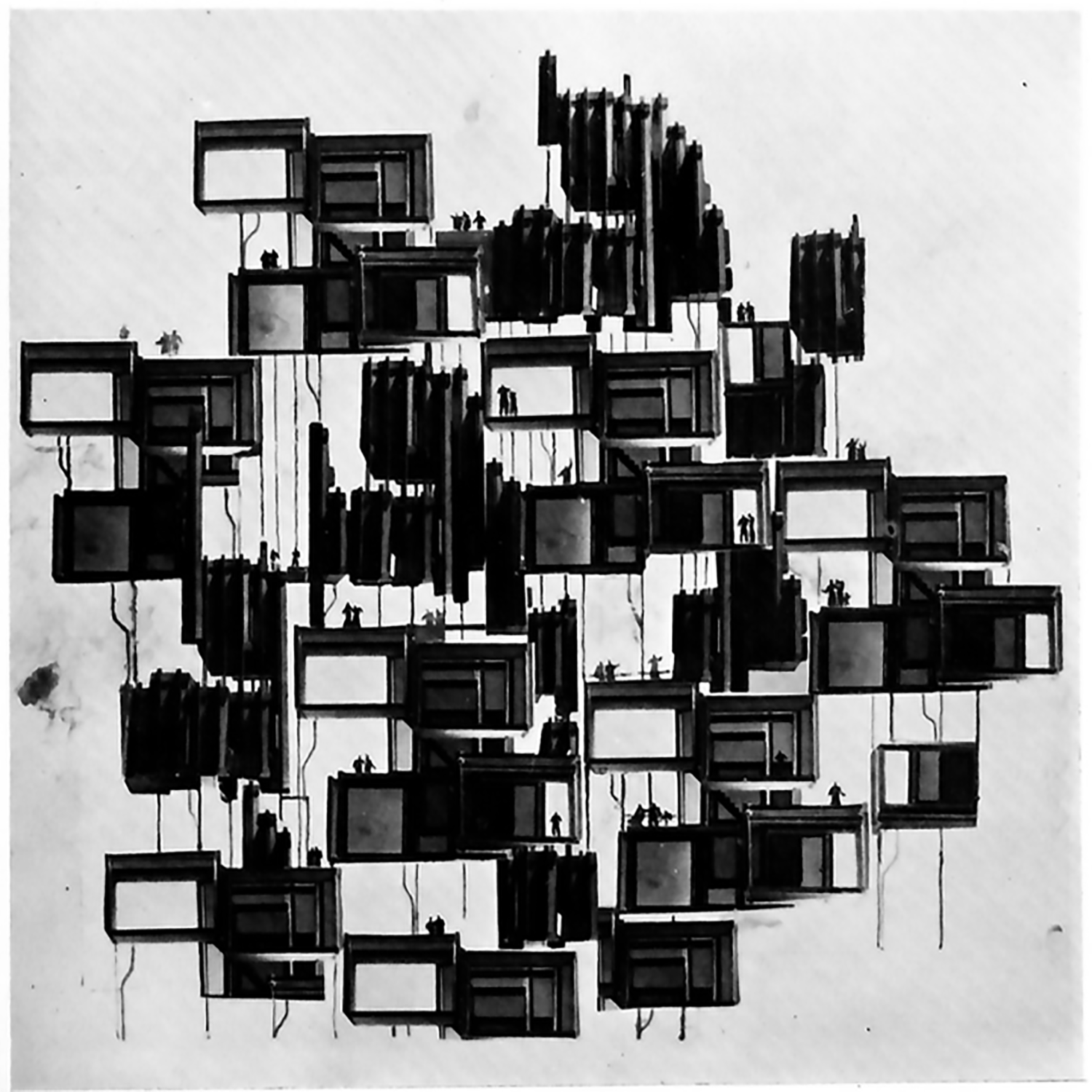
The winning entry for the Inarch Finsider Competition in 1967 can be seen as the prototype idea for the Casa Sperimentale.
Working with the ideas of a steel structure with suspended living and service elements in form of frames, Perugini envsioned the building elements to be mobile and reconfigurable. Each element is a basic frame fulfilling a basic function – an open space, a bathroom, a kitchen, a well segment etc. Each element had a thickness of 600mm with an element size of 2m, 4m, 3m and 4.8m. By combining different sized elements in a variety of positions and combinations it was possible to create an infinite numbder of possible inhabitatons.
Vaying the heights elements could have multiple functions—a floor, a bench, a table, etc.
Perugini was awarded the first prize for the “construction in the workshop of steel building types through the design of a living cell intended as a matrix of growing organisms”.
All elements were to be built in a workshop and delivered to site with all fixtures and fittings ready to be installed and inhabited.
The main space frame to support and hang the elements off were made of steel sections set into concrete foundations.
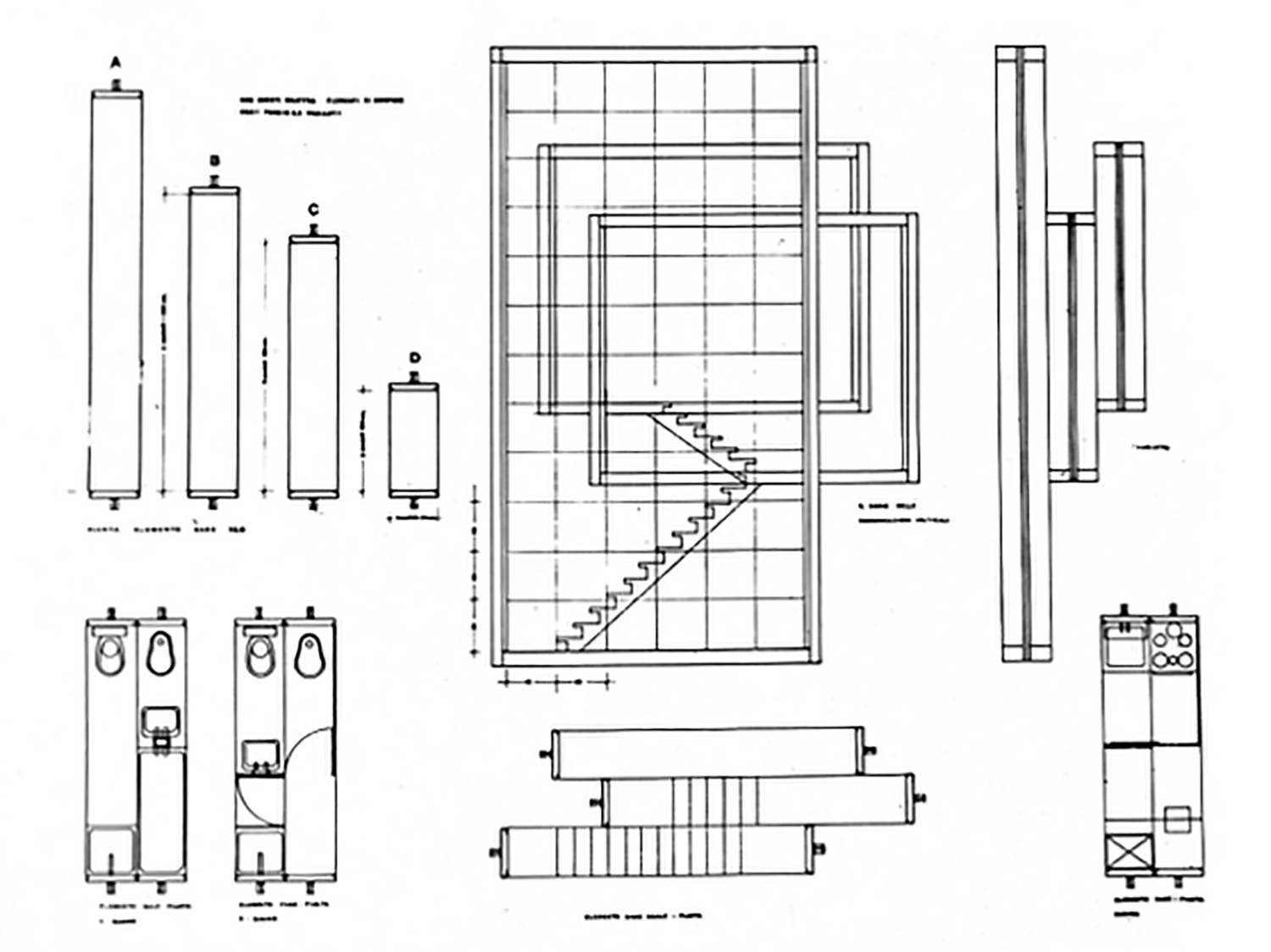
Drawing exploring the different elements and hteir possible combinations.
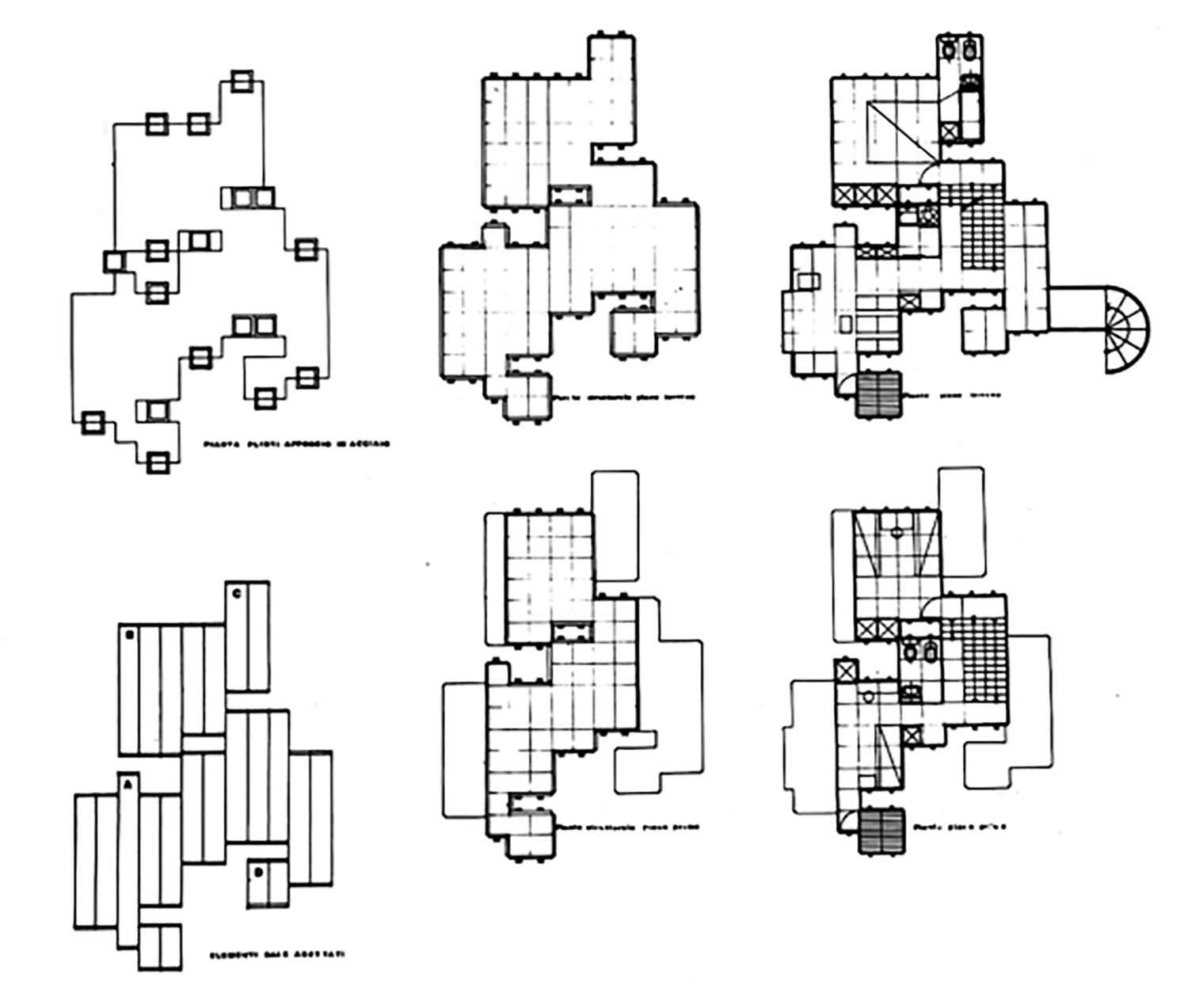
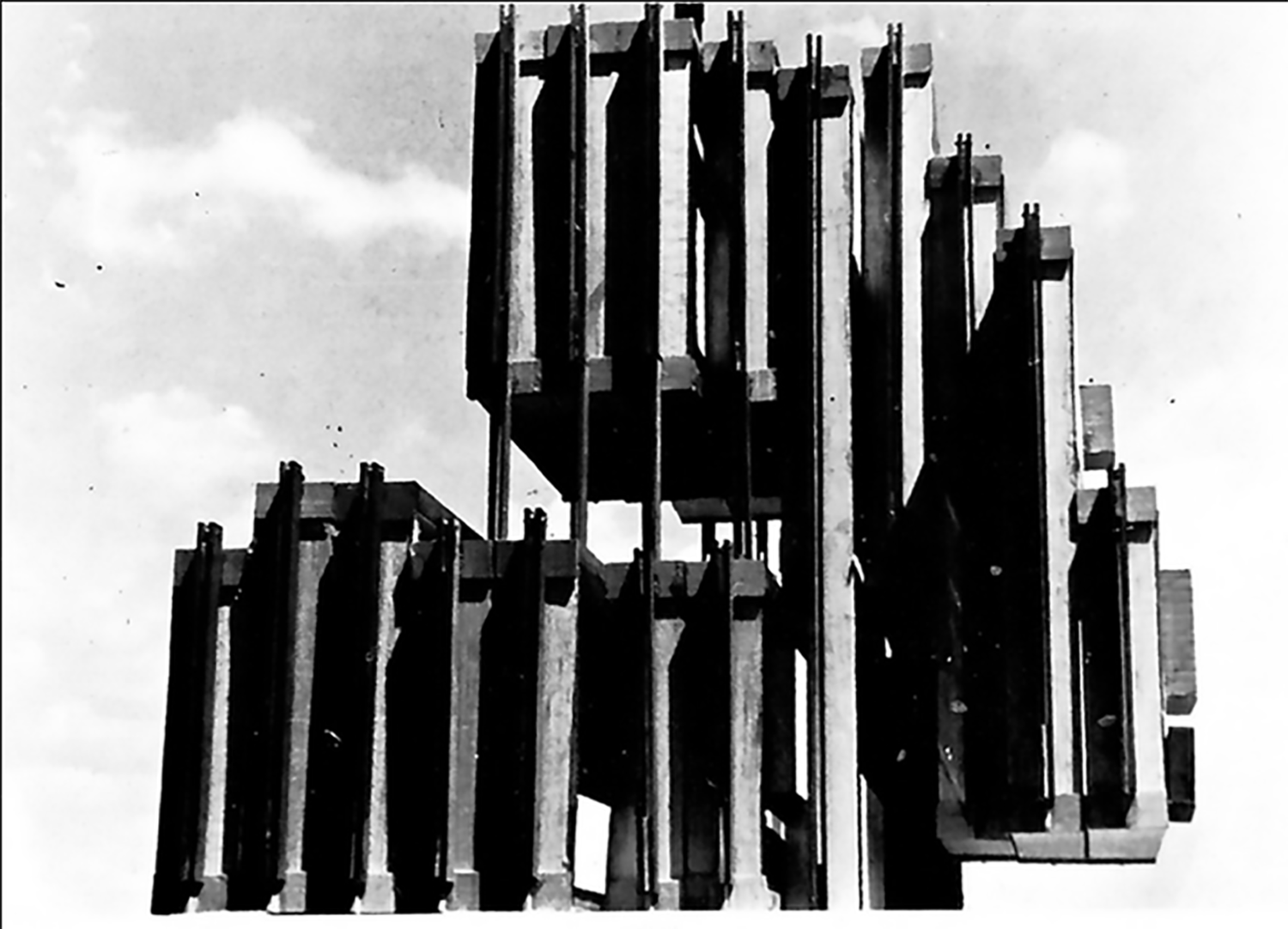
Model view of the 600mm elements bolted side by side to create hte elevation of the buidling.

The design and building process of the Casa Sperimentale had spanned over nearly a decade. The family started building the concrete mainframe with the idea of creating a treehouse. In 1967 the Perugini’s entered the INARCH FINSIDER competition. The idea was for a prefabricated steel structure suspended of a steel mainframe.
For the Casa Sperimentale, this idea was translated into a concrete superstructure. From the moment this mainframe was realised the process of decision making became much more democratic involving the whole family. Ideas were developed in sketches during the week and then communicated in site to the builder.
All contributions of Uga and Raynaldo were sketched and discussed equally.
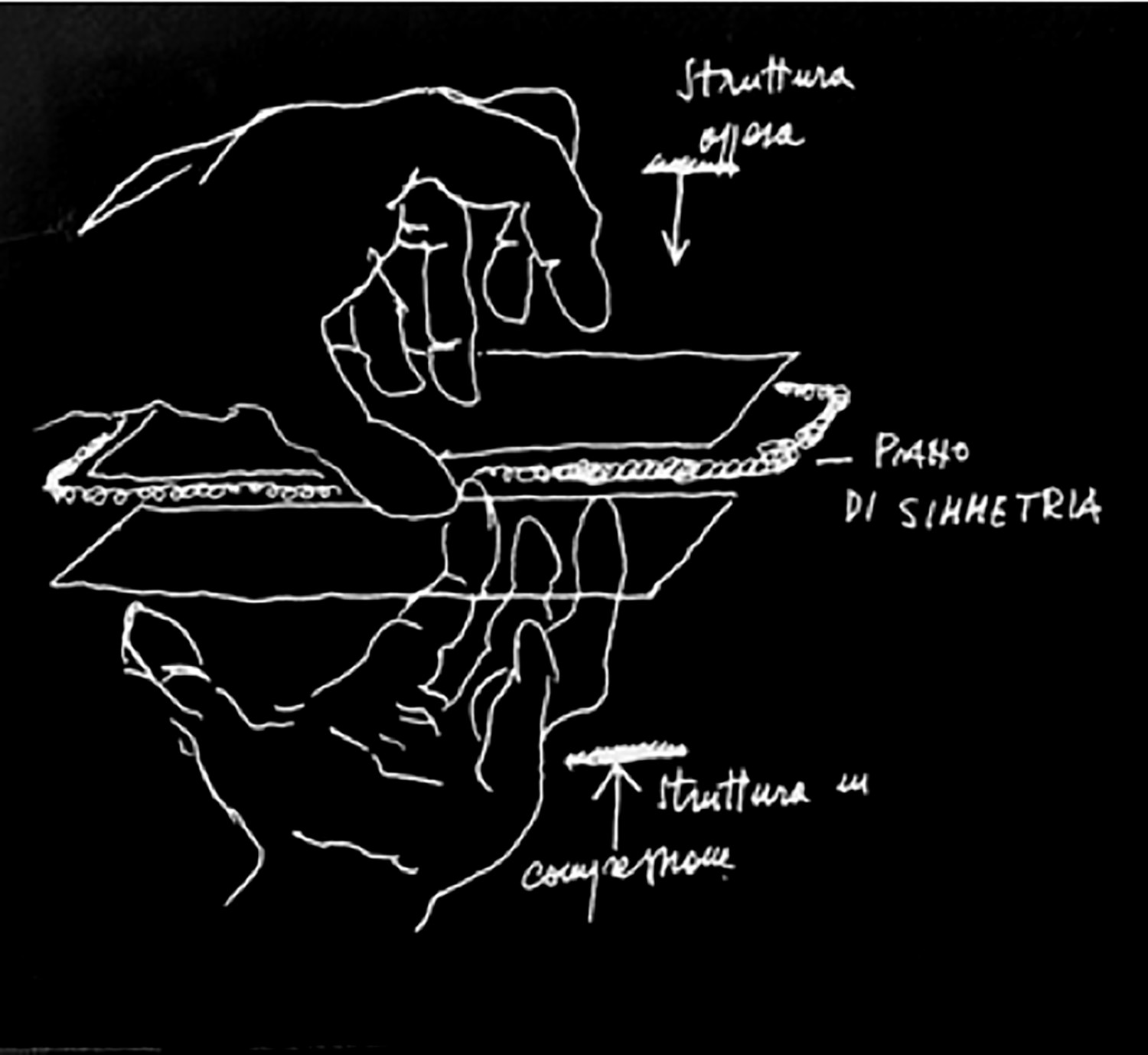
Conventional architectural principles were challenged, the floor and the ceiling treated as an independent element not structurally dependent on each other. The idea was to have a horizontal symmetry, mirroring the floor and the structure to create an open space inbetween.
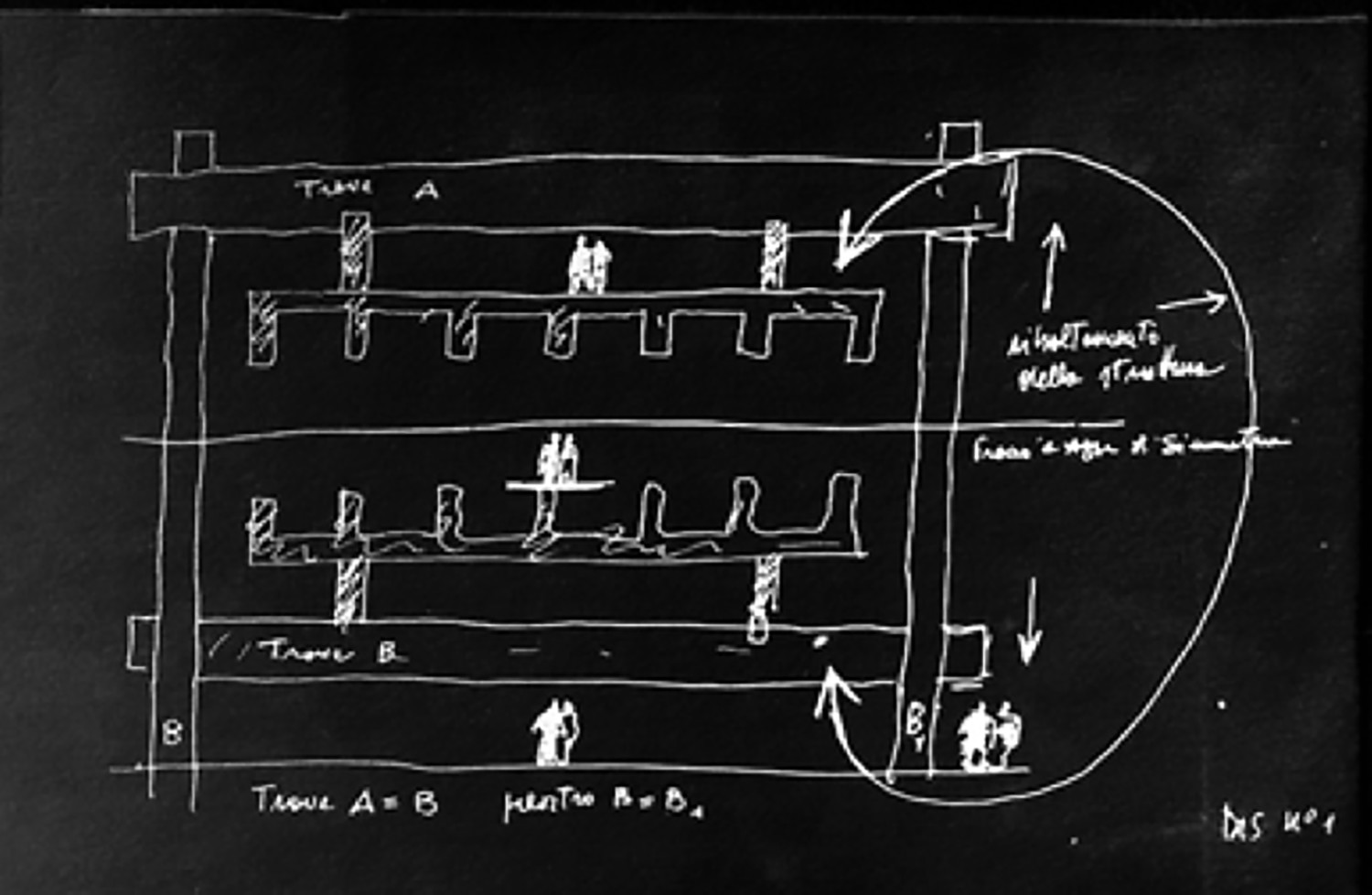
To enhance the hoizontal symmetry a pool underneath the structure mirrored again the underside of the floor creating a further visual echo.
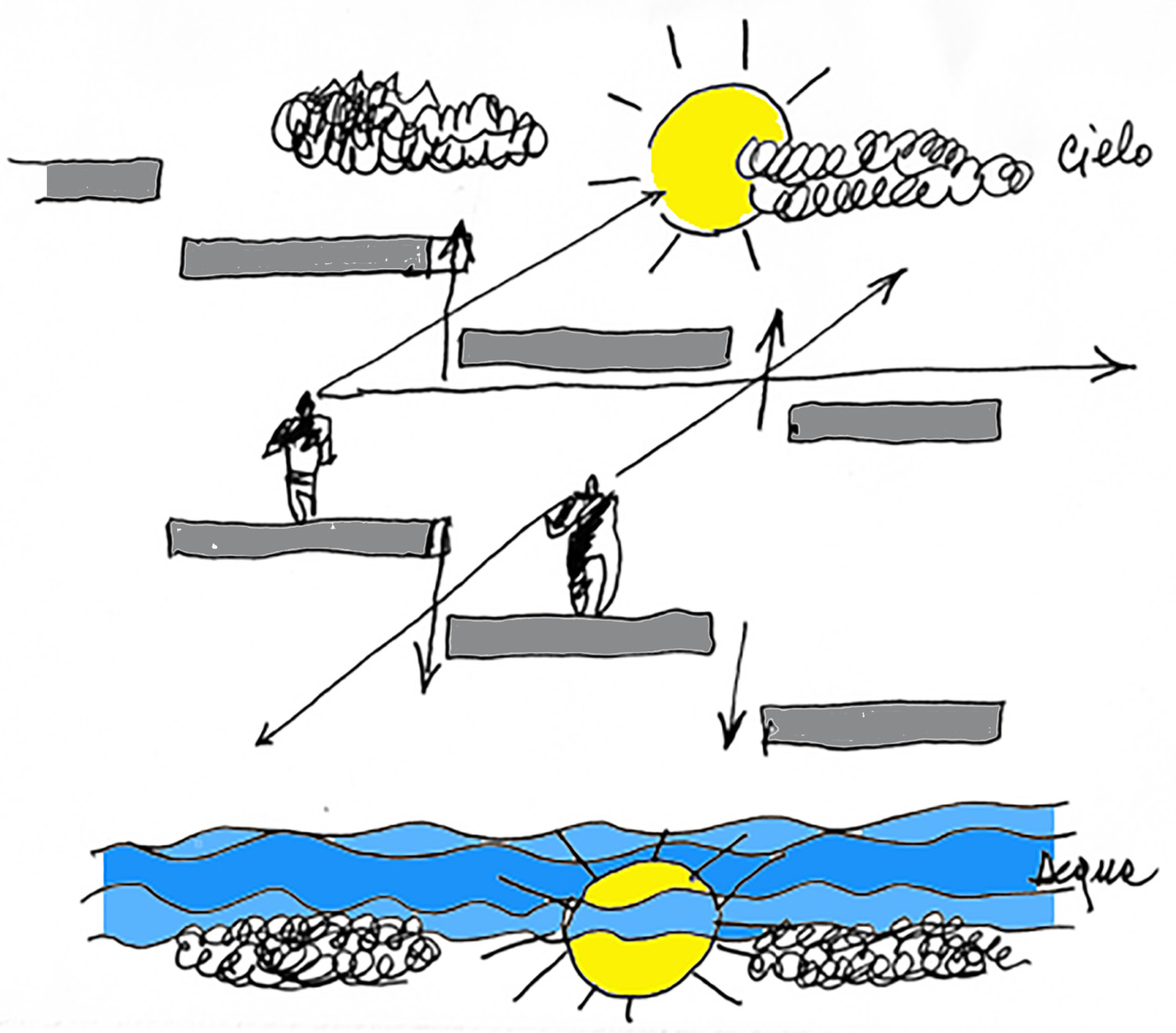
Perugini followed the Seven Principles for Arhcitecture promoted by the APAO and Bruno Zevi. To connect the occupant with the surrounding landscape and the sky above the floor elements were broken up and shiften up/down to allow a visual connection through the gaps to site below and the sky above. The pool underneath the buidling mirrored the sky again enhancing the effect by creating an upside down sky reflected in the water.
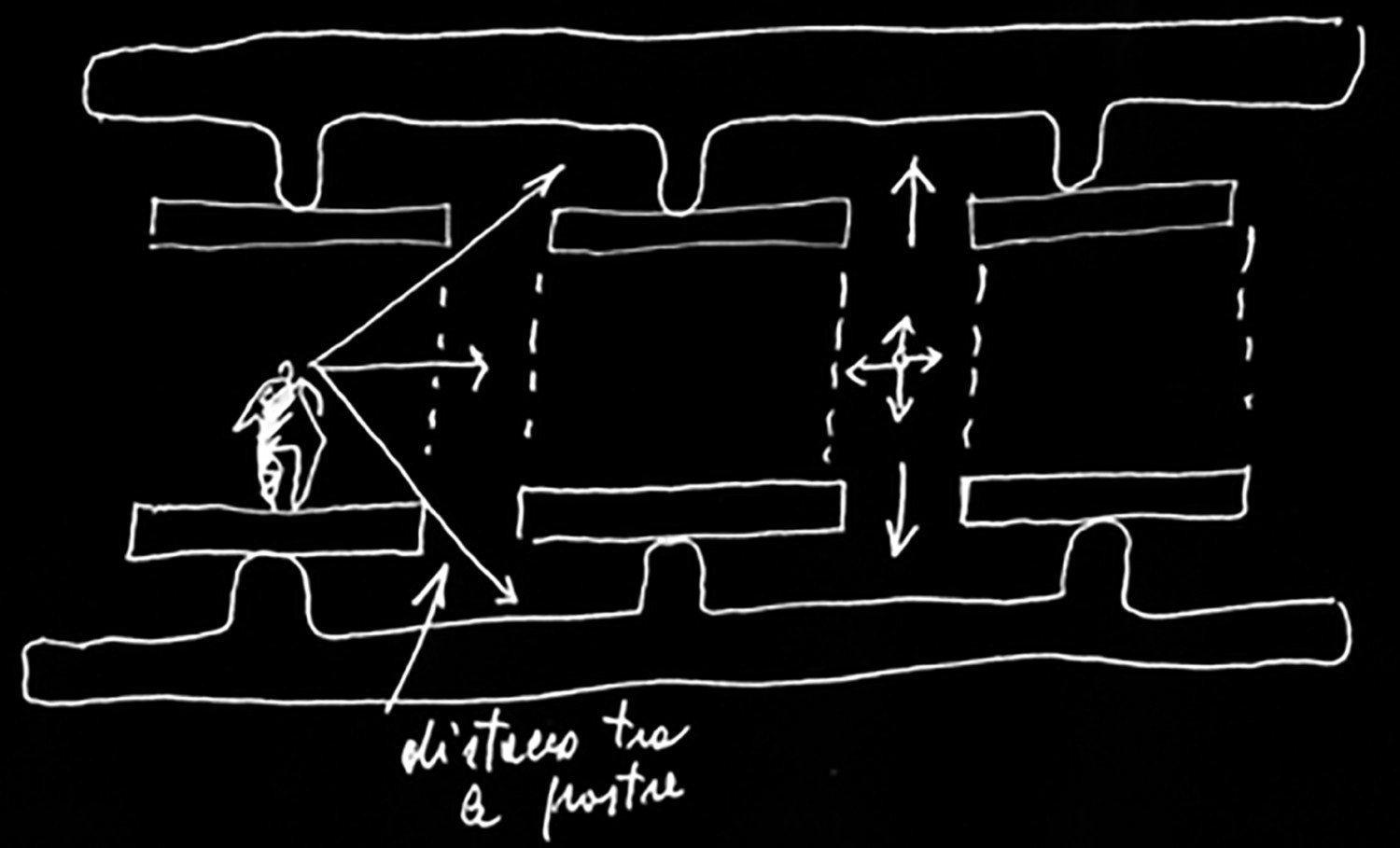
Each of the spaces occupied its own concrete floor panel, each of them independent from the adjacent element.
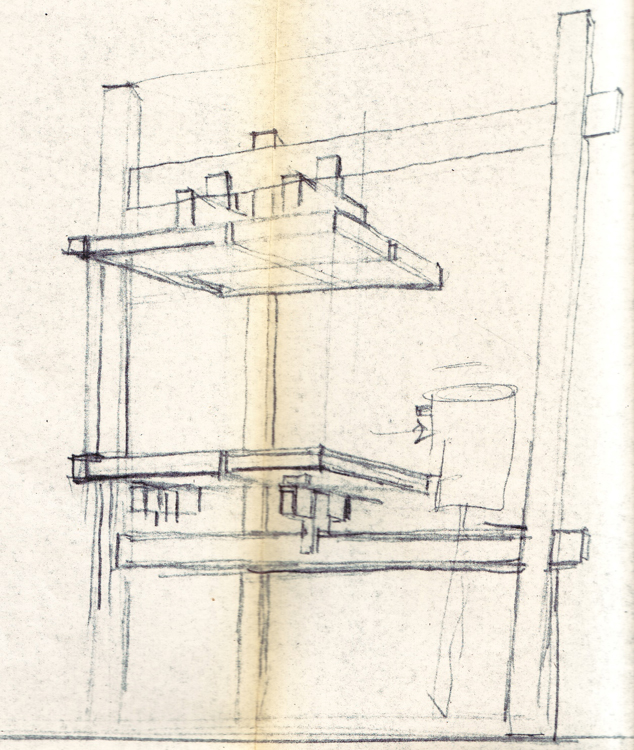
This sketch shows each of the floors being broken up into four independent elements supported by the concrete beam below and suspended off the concrete frame above.
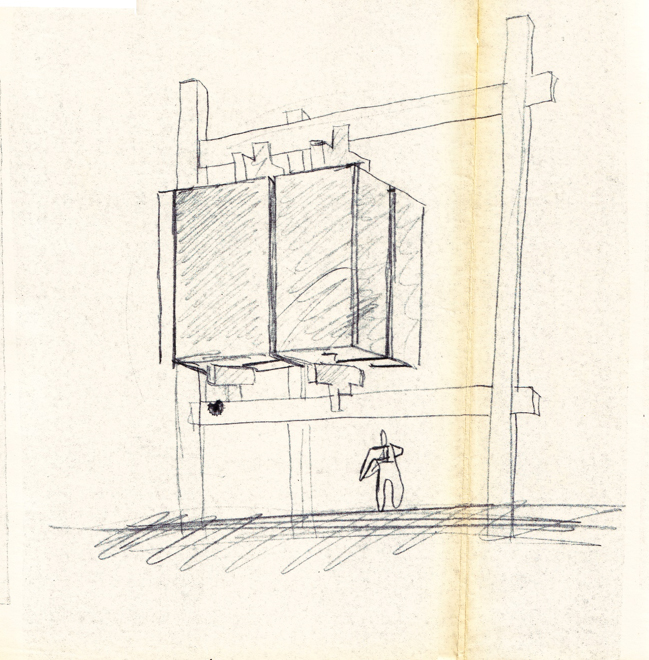
Giusepe envisioned the house as a pure concrete box with only slits leatting in light. After much discussion between himself, Uga and Raynaldo this idea was not followed.

This sketch explored the idea of seperating all the walls, floors and ceilnigs with glass strips echoing Zevis Seven Principles for Architecture.

A further ideas was pursued to introduce circular openings filled with spherical windows.

In the end, the family decided on a modular wall structure made of pre-case hollow elements. This could be lifted into position and then they could decide where to place solid elements and where to leave to window openings.

Sketch exploring ideas of coloured glass elements instead of the cuboid concrete blocks.
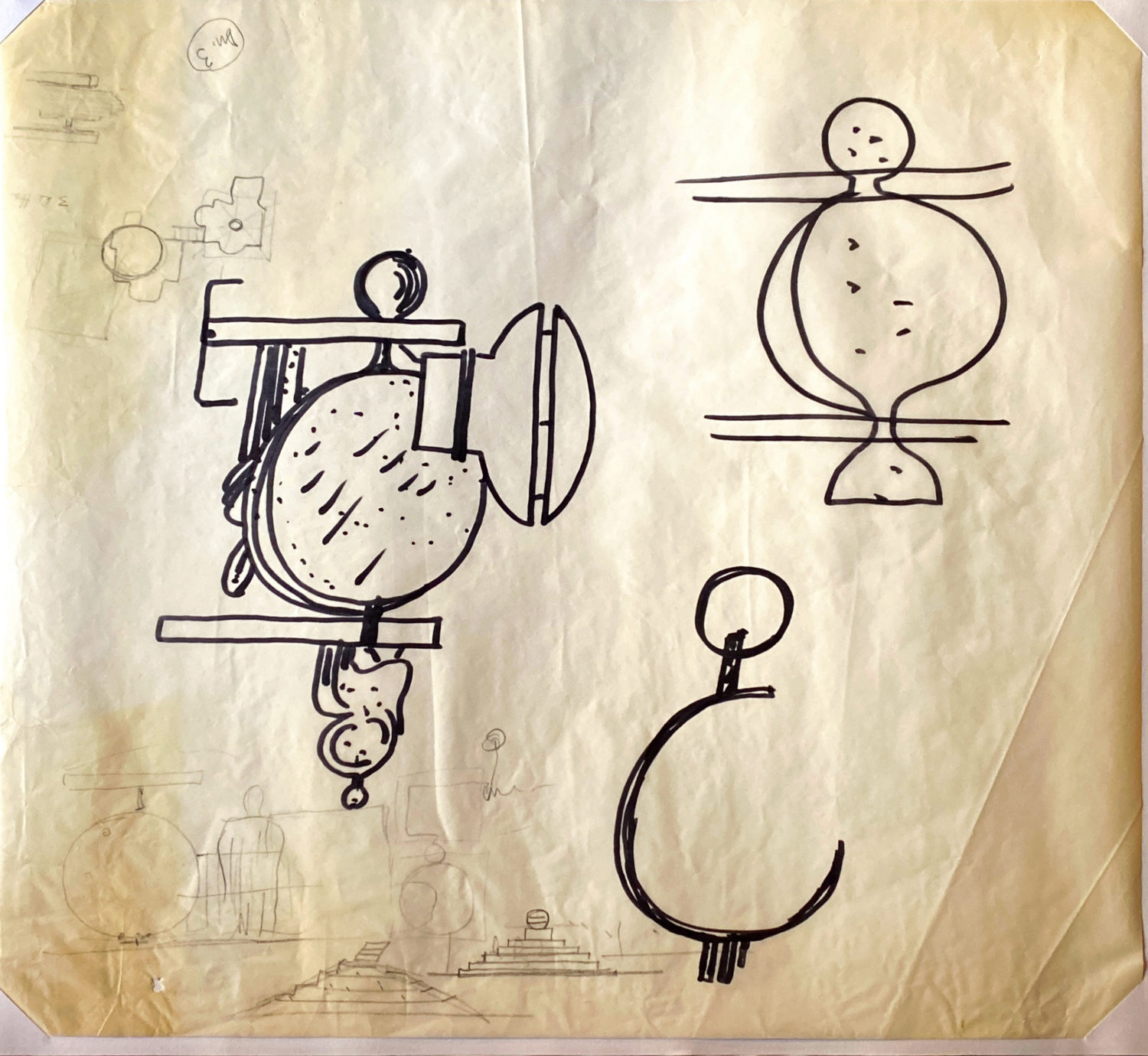
Sketch testing ideas of circular and globe-shaped elements used to create the spaces in the main structure of the Casa.
(All sketches are copyright by the Perugini family archive.)
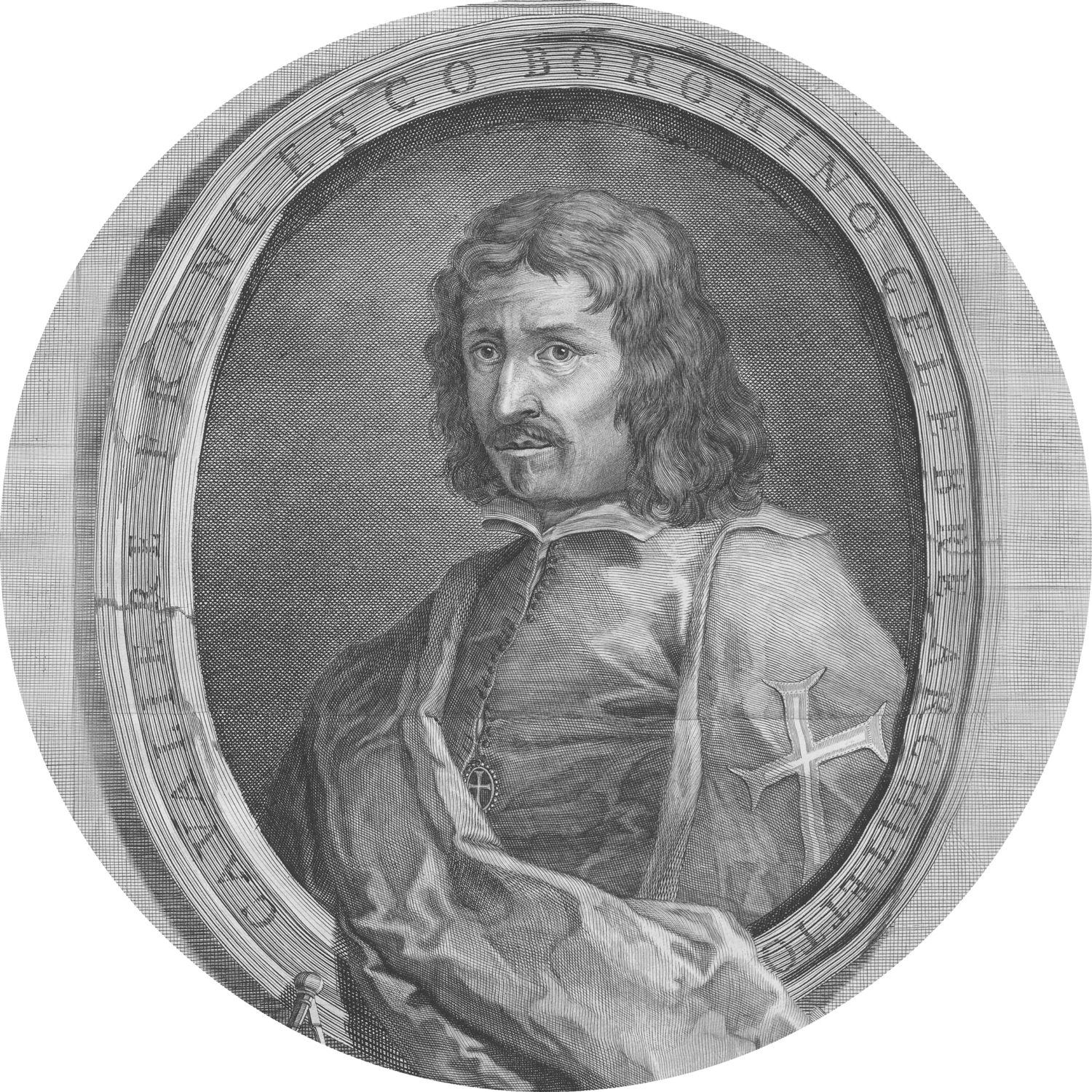
The Italian architect Francesco Borromini (1599-1667) was together with his contemporaries Gian Bernini and Pietro da Cortona one of the leading figures in the Baroque architecture in Rome.
Borromini is best known for his first solo commission, San Carlo alle Quattro Fontane, a small church complex in Rome.

Domo of San Carlo alle Quattro Fontane
The introduction to Opus architectonicum, written by his patron Virgilio Spada explains “…and I certainly would not have joined this profession with the intention of being a mere copyist, even though I know that the invention of new things does not reap the fruits of the labour, if not late, given that the same Michelangelo did not receive it when in reforming the architecture of the great Basilica of St Peter he was attacked for new forms and ornamentations…”.
Borromini didn’t just wanted to copy ancient orders and spatial concepts. He saw himself as an architect who ignored all the classical rules, as a creative person who ignored them in favour of inventing a new architectural language. The rulebook of the time, Vituvius ten books De architectura was still seen as a rulebook, a guide to creating great architectures.
For Borromini knowing Virtusius wasn’t limiting corset, it was rather an handbook to chose motives and patterns but then using them in a novel way to respond to a different set of restrictions. In the case of San Carlo the site was a difficult corner condition into which Borromini had ot invent a different spatial arrangement to create a sense of space. The walls, an undulating flowing set of concave and convex curves are structures using classical columns. Follwoing a plan that is played out in a series of circles the space is topped with a oval dome.
Each of the elements of the design is proportinally linked to the whole strucutre.
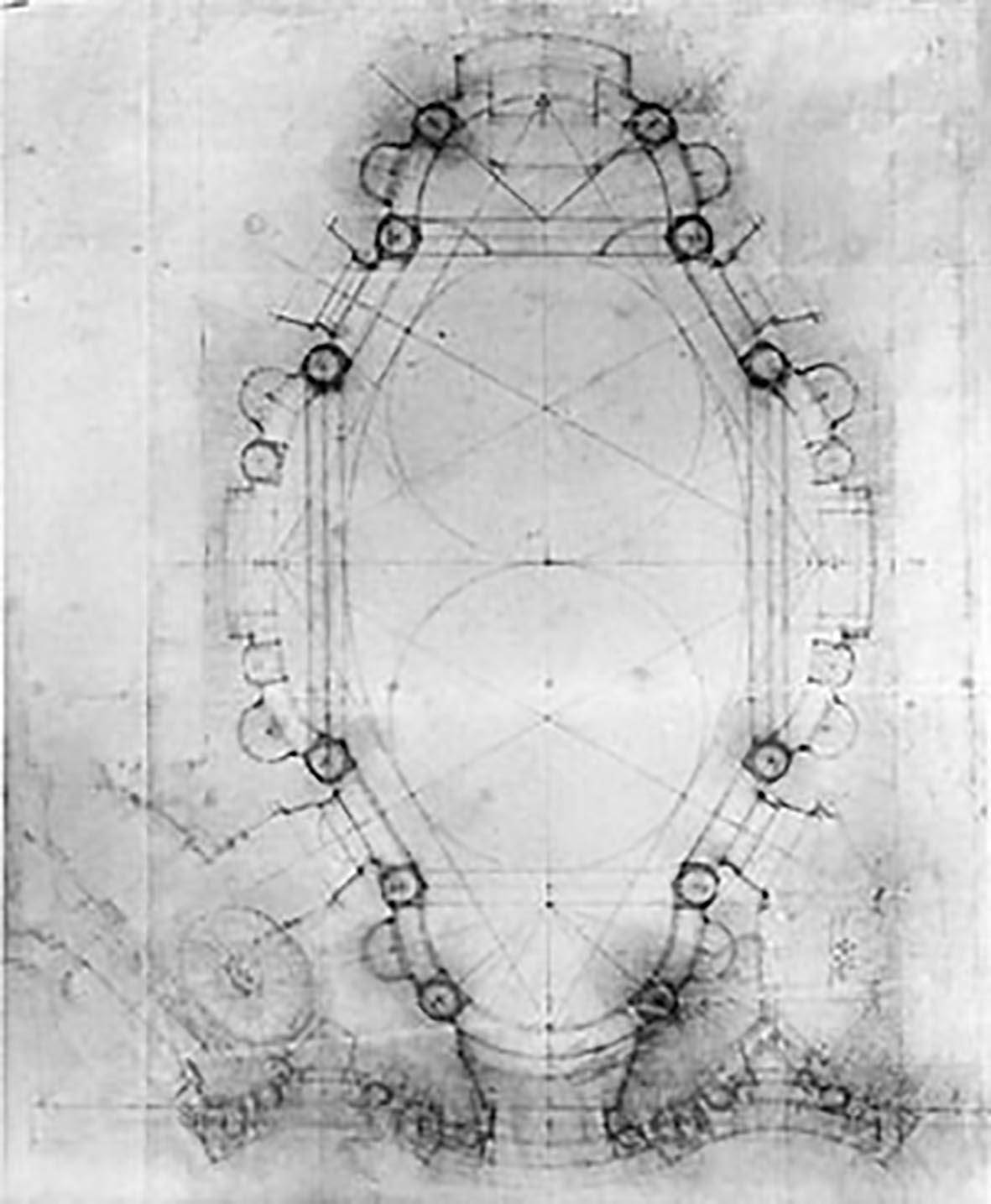
Plan study of San Carlo by Borromini
The research of Giuseppe Perugini led to a series of publications looking at the architecture and especially the geometry in Borromini’s work. He published a book on the history and the geometrical principles of his church Santa Maria dei Sette Dolori.
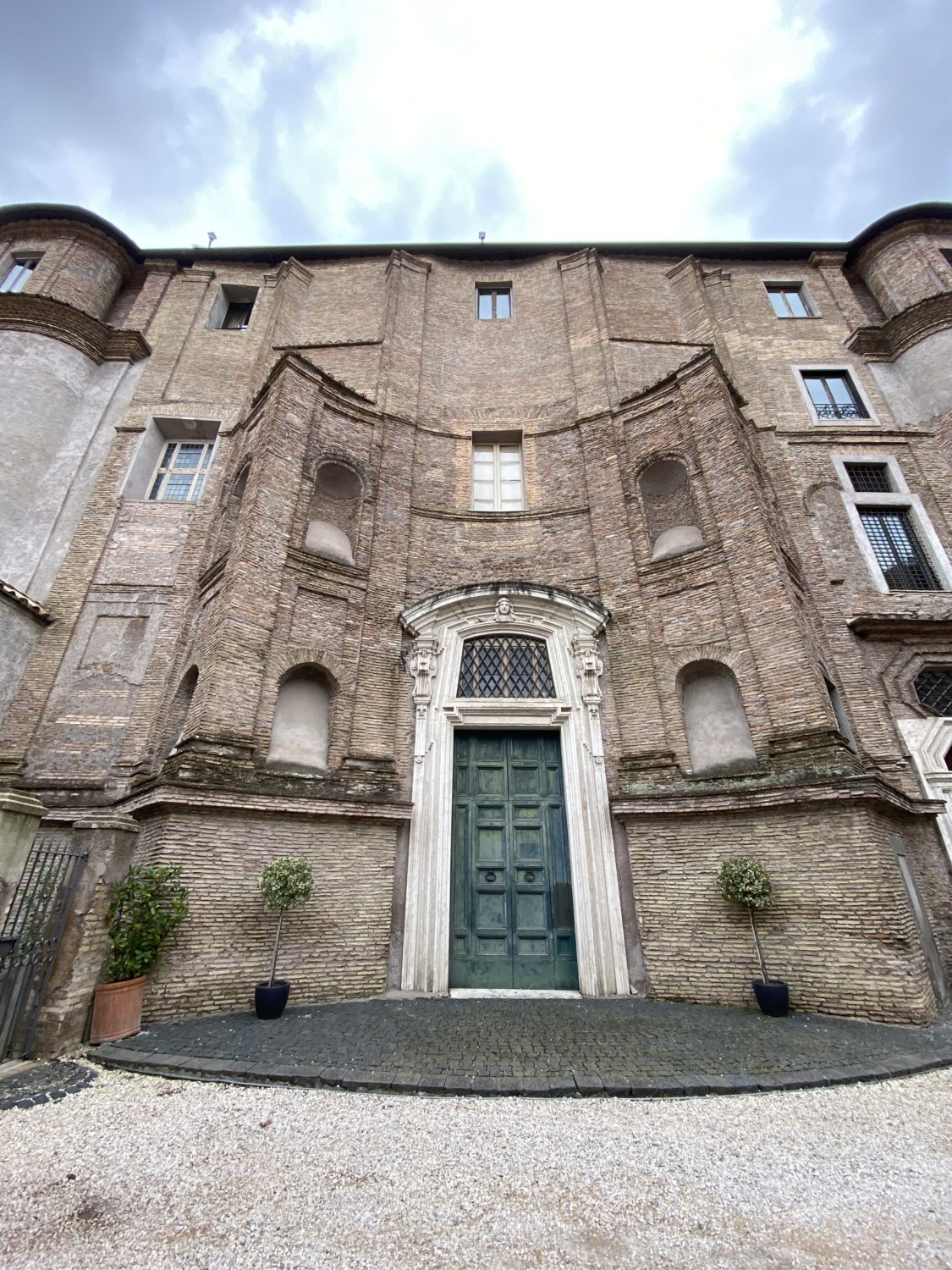
Elevation of Santa Maria dei Sette Dolori.
Church Santa Maria dei Sette Dolori
San Carlo alle Quattro Fontane
Vitruvius Ten Books on Architecture
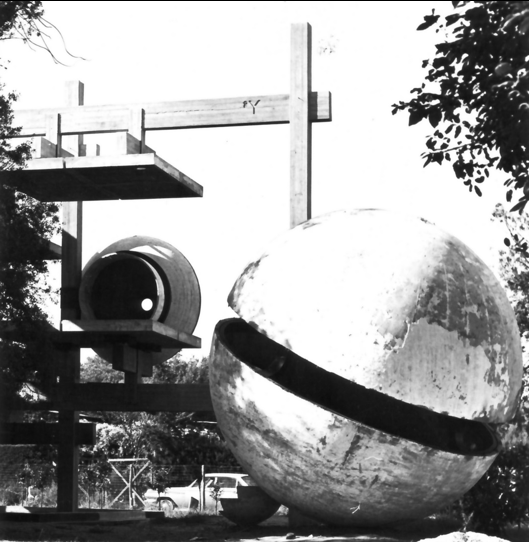
The Sphere next to the main house represents an entirely different concept of living. A micro house contained within a 5m diameter concrete shell.
To create the sphere the Perugini used the same method they tested for the creation of the bathroom shells. The shape of the half-sphere was hollowed out in the sand next to the site. A wooden scribe was used to even the sides and using a plaster the shape was defined.
Then using a second scribe slightly smaller the concrete was spread evenly around the mould. A mesh reinforcement embedded in the cast.
The centre of the scribe can still be seen in the azimuth of the spehere.
After completion, the whole shell was extracted with a pulley system and placed on site.
The second half was then cast into the mould. This second half-shell was mounted on top of a separating ring structure onto the first shell. This ring now contains a perspex transparent strip.
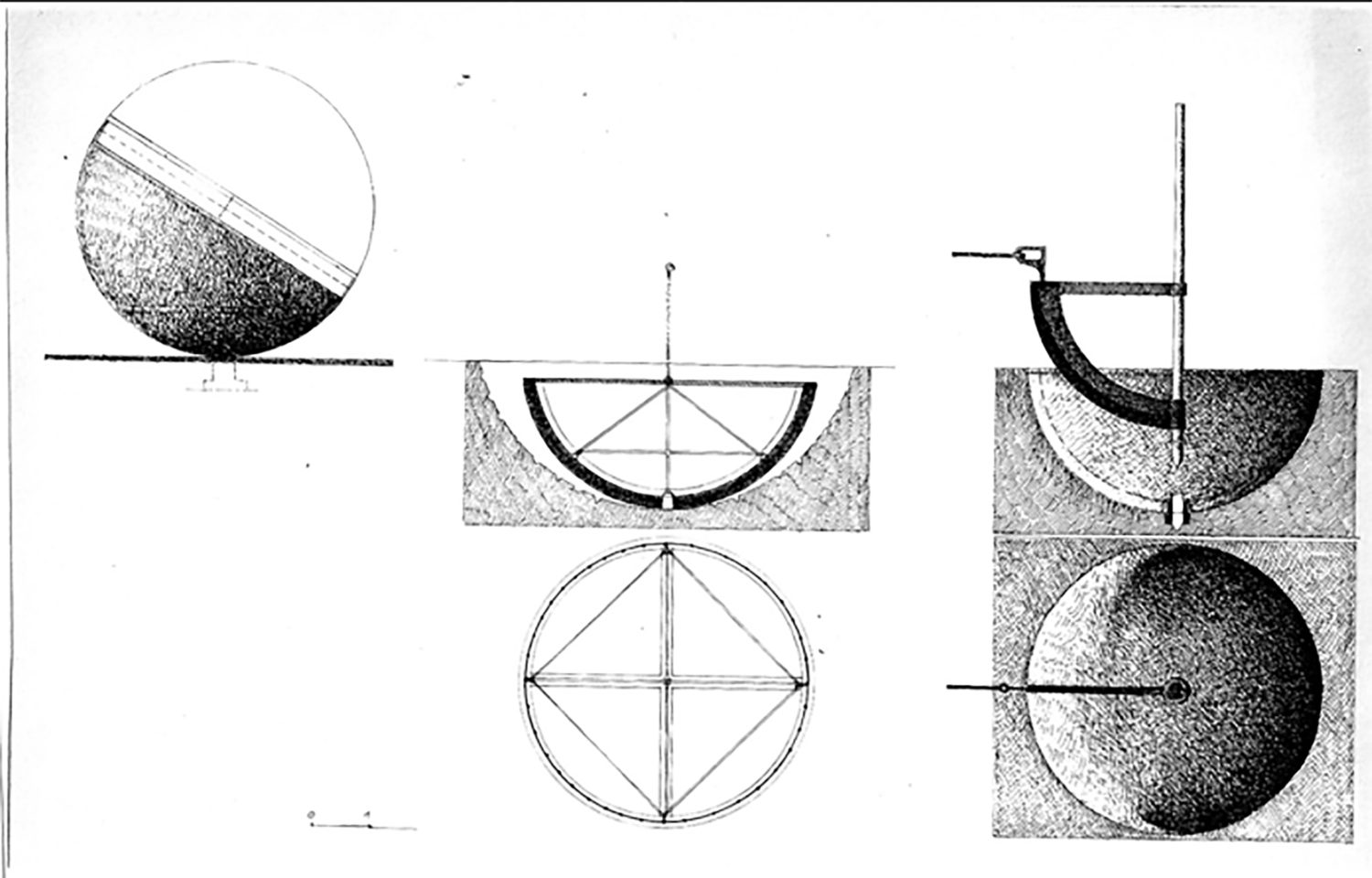
Sketch by Perugini showing how the half spheres were cast into the ground.
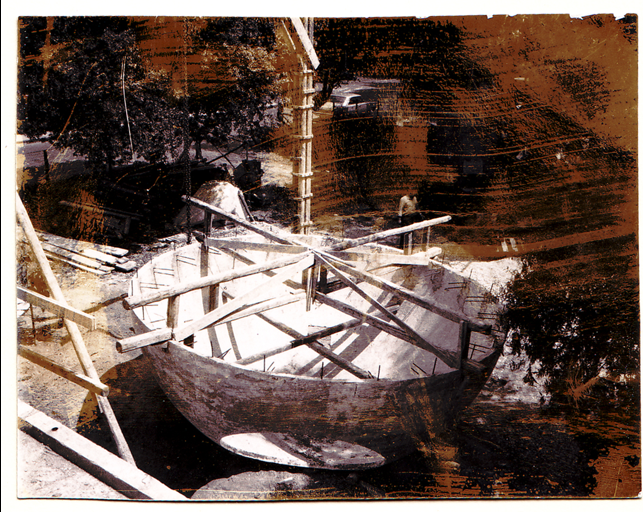
The first bottom shell after it has been extracted from the mould. The wooden support stabilised the fragile concrete shell during the extraction and mounting process.
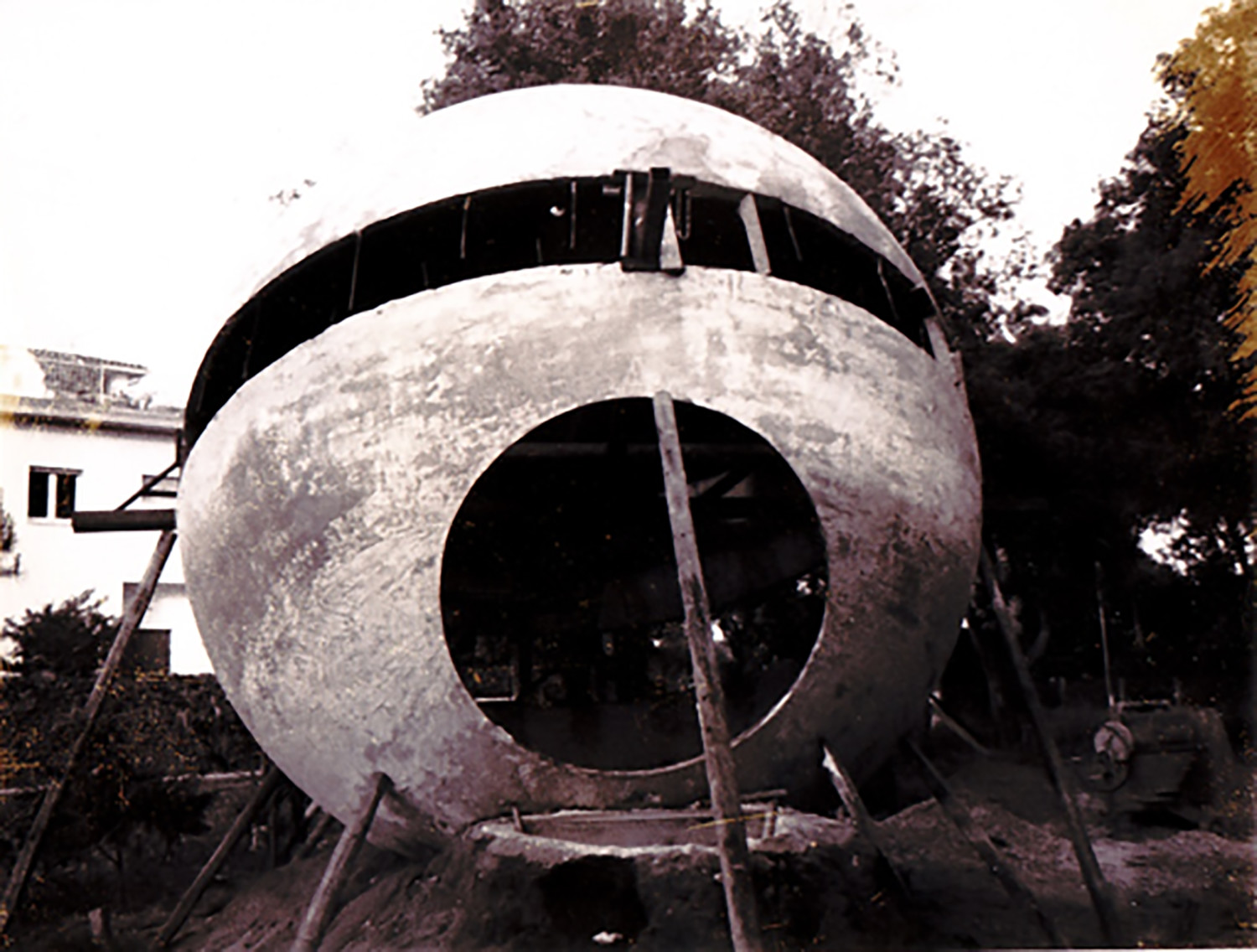
The top shell placed on the bottom half shell.
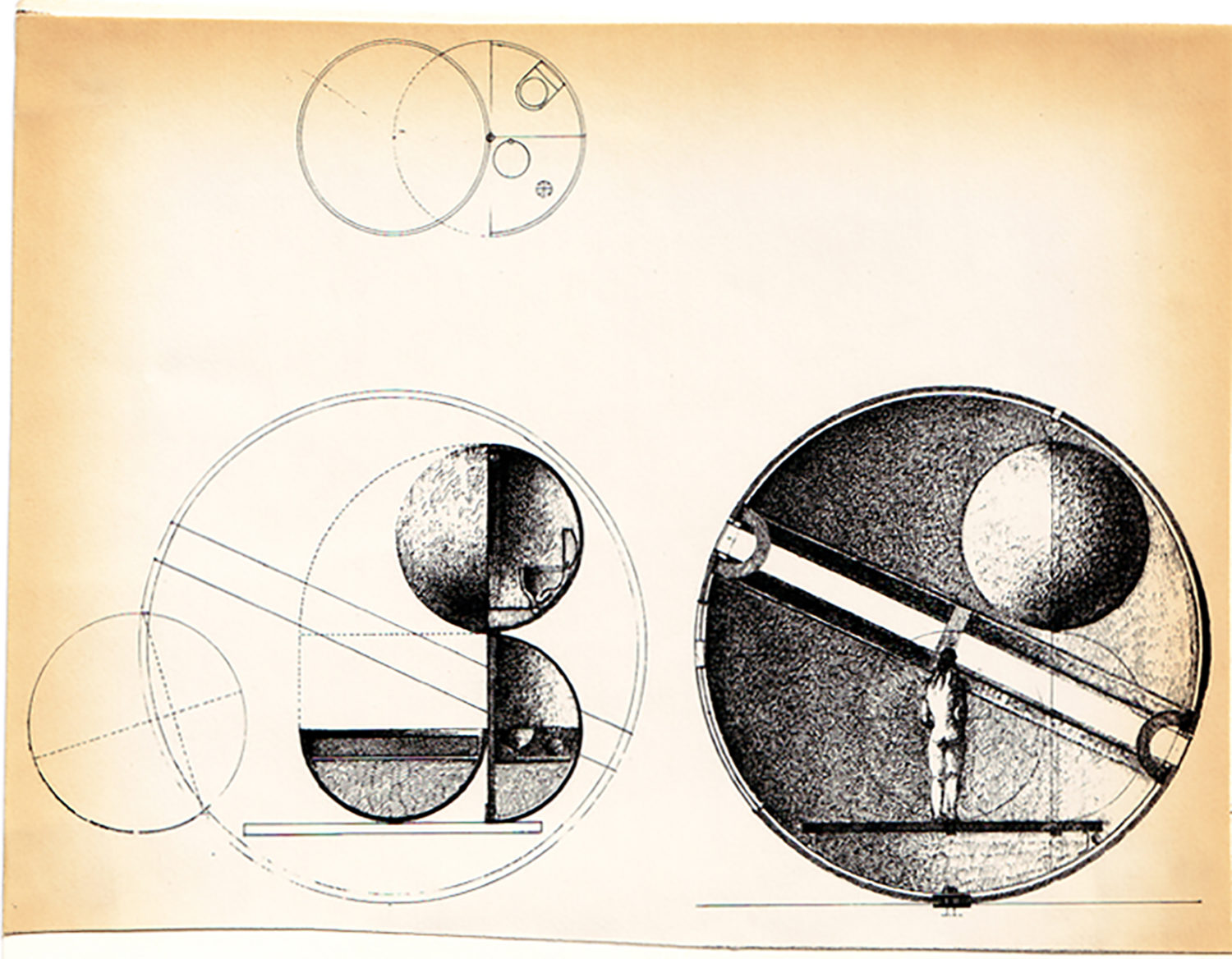
This drawing shows how the Peruginis planned to fit out the sphere. A suspended globe contained the bathroom and the bottom globe could be unfolded to form the bed.
(Al images copyright by the Perugini family archive. )
In hos book Casa Albero, Giuseppe Perugini writes this about the construction and the functions of the Sphere:
THE CONSTRUCTION OF THE BALL AND THE SERVICES
The inspiring principle of their construction is the system of potters. In fact, the first step is to carry out an excavation aimed at obtaining the space to make the initial mind the guiding form, which is also facilitated here by the sandy soil. A vertical pole is then fixed in the center with a welded iron sheet suitably shaped so that, by rotation, the desired shape can be obtained. After a first rotation of the shaped rod, which regulates the excavation, always rotating, plaster is thrown which, depositing itself on the walls, thickens and creates the real counter form. Then we proceed with the installation of a steel reinforcement made separately and fix a galvanized iron circle on the upper part of the resulting form. At this point the initial foil is replaced with one of reduced dimensions, determined by the thickness that is intended to be given to the element to be made and then the concrete is cast by still rotating the rod on itself until the cement has purchased a certain consistency. After the time necessary for the setting of the cement, it is necessary to dig around the counter form that is pining, thus releasing a perfectly finished object which is then removed with the crane and moved for laying. It is a substantially very simple system which, as in this case and if the conditions exist, it can also be carried out on site. The two half-caps that make up the Ball were also made in the same way but with further precautions. In fact, after having made the two parts that they constitute it, a particular COSTITU support structure was made up of a series of “U” beams – suitably pie gates – and large C in galvanized metal, while, as we have said, the choice to tilt the glass junction point made it possible to avoid a sense of static nature that a horizontal solution would have generated. The structure of the house and the ball under construction Scheme of the construction technique of the services and the ball.
Given the purposes that these short notes propose and the small space available, I think I will not have to go any further by recalling here the purposes and the “old-fashioned” method of the treaties whose purpose was to allow the dissemination of ideas, elements and their explanation. I understand perfectly well that Casa Albero can appear at first sight as an object in its own way eccentric, like the dream of a visionary architect, but I hope that whoever reads these lines will recognize its true meaning, its true role, which it is that of “mo of the experimental”, finding in the compositional choices made the concretization of all those values, even symbolic or unconscious, which have always been part of the very idea of Architecture.”
Giuseppe Perugini, Casa Albero
Raynaldo Perugini published a book colelcting some essays and writings of his father explaining the ideas and concepts behind the Casa Sperimentale – or like the family calls it – Casa Albero, the Treehouse.
The following text, kindly shared by Raynaldo,has been translated by us.
La Casa Alberto – Raynaldo Perugini
Casa Albero / Planimetry as a whole, short notes are in practice a sort of dutiful tribute to all those who have repeatedly asked me to publish my notes relating to a conference, which I held in 1979, dedicated to some research and I propose for an “architecture model”. This is a theme that is particularly dear to me as it has been the occasion for a global and correct verification of many ideas and many design interventions that I have carried out during my architectural activity. Activities that, as I have always claimed, must be above all and compulsorily understood as a constant, with the continuous, occasion of “research”. In the specific case of this architectural intervention, which I called Casa Albero, I was offered the opportunity to carry out studies and experiments on the object to be carried out without all the constraints and conditions that generally accompany architecture. And in particular, without time limits, this specific condition had the advantage of allowing me to be able to predetermine pause for reflection and verification without interfering with the development of the idea and its realization.
I must also say that the collection of notes and graphic documents published here constitute only a minimal part of the material produced during the period between creation and realization, as well as the indications resulting from this experience. In fact, the choice was made to favour the most significant works, also for obvious reasons of space. A more exhaustive publication will follow in the future that will collect and make interested parties involved in all the phases of a complex creative process such as the one that originated the house. However, I hope that what is published here is sufficient to stimulate an attitude of greater attention and awareness towards problems still unresolved in the field of housing structures, as well as re-proposing the reconsideration in terms of the topicality of the indications and results that have been handed down to us by the history of architecture).
GIUSEPPE PERUGINI Rome, March 17, 1983
Tree / Plant House at ground level with the projection of the building The Tree House must be considered as an architectural object that stands as a real “model to life”. Moreover, this concept is not new as there are some illustrious precedents in this field. Suffice it for this to think of Ludwig Mies van der Rohe’s transposition on a real model of the Kröller Müller House, which was then to become a valid didactic tool, or to the experimental neighborhood of the Weissenhof in Stuttgart. This example which, in addition to constituting a sort of synthetic repertoire of all the most advanced trends of the moment in the architectural field at European level, is configured as a remarkable expression of this “modelling” in scale 1: 1 which we are talking about. Thus, offering to objective criticism some of the most significant spatial experiences in the history of the Modern Movement. Not to mention the fundamental experimentation with scholarship in the field of non-specific and object defined by Kurt Schwitters, a leading exponent of the Dada of Hanover, manifested consistently in his model of the true home – sculpture: the Merzbau.
However, it should be clarified that this project experience which I am going to describe, while ideally linking to these illustrious precedents, has particular values which are proper to it. Conceived in the context of a series of proposals and operating schemes designed in 1968 with the intent to unlock, even without openly contesting it, the traditional typological configuration of the housing structure that has long since crystallized, and, at the same time, to overcome the assumption of the pre-constituted functional organicity, the basic idea of the Tree House has come to open itself more and more to experimental initiatives of various kinds which have gradually emerged during the various phases that led to its realization. Thus, among the alt, the perceptive assumptions were also taken into account, resolved – as already in the Memorial of the Fosse Ardeatine I designed in the 1940s – through the introduction or accentuation of particular scientifically elaborated corrective motifs that flanked by more purely structural features. The final aim is not in “form” but rather in the possibility of proposing an architectural solution which contributes to solving some problems of the conscience with the convergence of a series of cues soon the susceptible tonic possibility and cues of different origins.
The experimental principle that underlies the House, therefore, must be verified not so much by evaluating only the results achieved, but rather by proceeding with the analysis of the creative process, because it is precisely the latter that can reveal the correctness of the criteria that contribute to its final conformation. In light of this, the “technical” structure of the architectural object is naturally based on the maximum of constructive essentiality, also because I agree with Mies’ theory that technique must not be “a field of games like it is not. architecture, whose spatial dimensionality must always be correlated to the quality of life that takes place in it “.
Furthermore, the particular principle of mechanization and total standardization applied here, which by nature allows to create a range of almost infinite aggregation possibilities – a real “non-finish-able” rather than an “unfinished” – thus allowing to obtain a wide variety of spatial articulations starting from a single rule, does not refer simply to the House Tree object as an end in itself but rather to the development of a real methodological process. Evidently, on a superficial analysis, the abolition of the classic typological – functional criteria could raise some doubts, above all of an economic nature, being this particular aspect of the problem directly connected to the traditional principle of standardization of housing. However, it must be considered that the growing complexity of our needs, which require ever greater flexibility, will necessarily have to take into account new factors in the near future, even if substantial differences are not yet perceptible. Considering also the fact that the emancipation of the living space from the structure, a real conquest of the senses of architecture. modern, it represents a significant step forward in all All these assumptions have been concretized here, as far as possible, during this “applied research” which, as I was able to say, is not proposed either controversially or as a solution to the alternative but, he simply wants to recall, albeit in an unspecific key, some traditional architectural parameters so that, appropriately rereading, for a more current position in the area of contemporary design.
At this point it could be objected that the uniformity of the typological standard is actually being proposed in disguise and for this reason it is necessary to further clarify the basic concepts through further clarifications. The “typological standard”, as it is normally understood, is synonymous with uniformity in all senses and foresees in its interior, and at the same time, a fruition considered optimal as uniform as possible. In our case, on the other hand, the socio – economic aspect is resolved through an equitable distribution of the liveable space, but at the same time the user is also given greater freedom through an almost infinite range of organizational possibilities, in order to achieve a inhabited space with the indication of the “walls – furniture” optimal distribution of spaces and functions within its environment free from predefined schemes. And this is why the service units – bathrooms, kitchen, stairs – have been designed as totally autonomous with respect to the main structure and do not affect, as we will see, the economy of living space, as well as the fixed furnishings. All these functional elements – and in particular the bathrooms – were in fact conceived to be placed outside the main structure, “hung” where necessary, thus performing their traditional role in an autonomously and without interfering with any extensions or re-readings of a continuous “architectural context” evolution.
THE EXPERIMENT
It must first be specified that the experimental process of the Tree House does not end in a single architectural object but extends to a complex of experiments consisting of three episodes, three “tests – object “. The first is the real Tree House, the second is divided with the codename “Palla” and the third the “Cubetti”. Three architectural proposals conceptually correlated in order to express three different ways of understanding the concept of housing unit. Thus, to the naturally unlimited and indefinite – or rather “non-predefined” – structure of the Tree House, a “finite” object – identified through the spherical shape, a symbol of self-realization and cosmic perfection – and an object with linear variability, achievable by applying the principle of seriality.
The first of these “urban scale models”, the Tree House, essentially consists of a load-bearing structure, completely external to the functional spaces, created as an example of aggregation of a series of standardized elements – beams, slabs and plates – which could be defined as a “structure – matter” in that it does not present any quantitative limitation of use and is likely to develop indefinitely in all directions. The second “model”, the Ball, consists of a sphere of five meters in diameter internally equipped rationally as a housing unit. The third “model”, the Cubetti, consists of a sequence of cubic spatial modules of three meters by three spaced by semi-modules containing the services through which you get a housing unit consisting of two rooms, kitchen and two bathrooms less forty square meters.
In this case it is a “cellular” experimentation organized according to the principle of the aggregation between modules and semi-modules possibly expandable also in height by overlapping. Although apparently very different from each other, these three examples of experimentation are conceptually connected, as well as by precise modular choices, by the same purposes and by the same common values aimed at proposing new criteria for the design of housing structures.
EDUCATIONAL ARCHITECTURE
When we aim to organize a didactic orientation system, we must necessarily put this system into reality. And this is the case of Casa Albero, a cultural and architectural operation which, in transcending its objective characteristics, it proposes itself in a specifically didactic role. If, in fact, he speaks of didactic architecture, or rather of the teaching of architecture through architecture itself, understood objectively, we must necessarily consider the more directly codifiable aspects. And this neglects the dialectics of languages and theories that are considered already acquired for a concrete evaluation of reality. And the real, in turn, must present itself with clarity, without ambiguity, easy to read, so that by following the consequentiality of the operations, the synthesis that determined it can be recomposed. It does not seem out of place to me at this point to refer to Mies’ reflections, as I believe that this will make the understanding of this aspect of my work easier. The elementary synthesis, writes the German Master, “always finds its roots in the healthy world of primitive construction methods (…) In fact where can we find a greater structural clarity than in the free constructions of the ancients? (…) Where could one learn such a simple and healthy profession as that of the architect if not from these modest unknowns? “And above all:” this is no less true for steel and concrete, we must remember that it all depends on how we use it and not from the material itself. Every material is what we don’t make it be.
The Tree House, a real “continuum house”, is based on an elementary, primitive, and therefore easily understandable structure. The Palla, with its historical form, proposes itself here with its vocation to abstraction, opposing the House with its modification by balancing its experimental criteria with a different reading station. As it is well known, the sphere and classical form, which has repeatedly recurred in the course of history – just think about the visionary images, the sphere is one in the course of history the visionaries of Tree House / Cross Section II Étienne – Louis Boullée or Claude – Nicolas Ledoux -, but which with its synthesis escapes the succession of fashions and styles. And in this case, to make it livable, another equipped sphere has been introduced, destined to fulfill all traditional functions, including furniture. Furthermore, it was decided to reject the static nature that would have been generated if the glass cut that connects the two battles that compose it had been horizontal. Thus, by tilting its barycentric axis, a further naturalistic motif was introduced, that is, a relationship for earth-sky that exalted its dynamism and tension. A tension further strengthened from the outside by the bronze ideogram that draws a cosmic image on the white marble floor.
Thus, if it is true, as Adolf Loos states in the essay “Architecture” of 1910, that “architecture arouses in the man of moods” and that “the architect’s task is therefore to specify the state of ‘soul “, it is equally true that when an architecture is open to provoking an emotion it is possible between transforming into an” architecture lesson “. And this is basically of another of the characteristics of these architectural experiences.
THE SEARCH FOR A SYMETRIC FLOOR
The structure, as you can see, is symmetrical with respect to a plane of symmetry that can be at the height of the human nail. This is obtained by equating the structural door leaning with the hanging one, so the hooking elements of the plates that appear free in space are not perceived. For this reason, the first sensation is that of levitation, but the view of the bearing structures through the voids determined by the offset of the plates themselves produces a sense of stability. These two converging moods de facto determine a dynamic succession between abstraction and concreteness which provides, on a psychological level, a third state, synthesis of the two components.
The effect that this state of affairs produces means that rather than being in front of a “container”, one has the impression, when confronted with the simultaneous presence of an interior – exterior, of an architectural object that is interpenetrated or even partially of nature.
From this derives the denomination of Casa Albero. The house, even internally, does not have completely passable hierarchies, all visible. There are two “exteriors’ that are actually usable and which refer to each other: A “below” and an “above “. What is above is like what is below.
So, for the persistence of the memory, you have the feeling of an effective continuity, even formal, which, by reducing the elements of distraction to a minimum, favors the understanding of the project idea. While A structural criterion of this type, which can be “tipped” in a single-storey oven, allows ideally following a potential overturning movement and fully appreciating the entire structure through a conceptual path.
THE PLATES
The modular plates, independent of each other, are connected to the structure – hung or supported – by means of cruciform steel brackets and are spaced by a transparent glass plate six centimetres wide. The volumes closed with the cuts of light. This slit, which we find, symmetrically, on the ceiling and on the floor, also continues on the walls in order to create a linear continuity, a sort of “glass cage” of luminous glass, through which it is possible mentally reconstruct, in an obviously evocative way, the sequence of volumes that make up the building.
ACCENTUATION OF THE PLAN OF SYMMETRY
To control the plane of symmetry further, the “House” stands on a stretch of water so that both the structure and the sky itself find a further chance to reflect. Of course, the simultaneous vision of the sky also bears the reflected sky that derives from it, perceptible from inside the building through the slits that separate the plates and the glass parts that underline the staggering. it contributes to further enhancing the sense of tension and “suspension” which constitutes one of the main characteristics of this architectural experiment. Perception across the board.
THE TABLING AND WALLS
A premise is needed here: the characteristics of the load-bearing parts of the building, completely external, eliminate any static constraint and this consequently allows to be able to operate an almost unlimited choice of infill, This freedom of choice has led – in the course of planning and above all in execution – to formulate a series of potential solutions among which the final choice was made. A choice that in a certain sense recalls the observations of Adolf Loos who in his ‘Spoken into the Void” addresses the problem of “eliminating furniture” by postulating: “there are no modern furniture”.
In fact Loos writes: “ …Only those modern furniture that can be moved are modern. All the furniture that is fixed to the wall, which therefore cannot be moved, as it is already clear from their nom are therefore real furniture: chests and wardrobes, glass cabinets and sideboards, today practically there exist more (…) We were said that in every age the wardrobes and the cupboards had been conceived according to the modern spirit, designed according to the spirit of their time and that therefore it was the task of creating these things even today according to the spirit of our time. This was a wrong reasoning. Because, since the wardrobes no longer exist today, it is possible that there are modern ones “. And therefore “What must the truly modern architect do? He has to build houses in which all that furniture that cannot be moved disappears into the walls. (…) The walls of the house belong to the architect. Here he can do this who wants “. This is the spirit with which the equipped modular system that constitutes the walls of the Tree House was conceived. But, it should be noted, that Loos’ words have not been reported here to defend the solution adopted but rather to demonstrate that it is also possible not to “make the furniture that cannot be moved disappear” in the walls, choosing instead, as is the case, to create walls with what plastic value of our construction and rear curtain walls have been defined as “fixed furniture”. In fact, the plastic value of our Finished by the insertion in the Qulin concrete infill panels made out of work which become, from time to time, wardrobes, bookcases or containers with vainness and which make up the walls, an internal space that appears visually more g than it really is.
The assembly of these elements was carried out by means of suitably threaded steel bolts. Once fixed, the cohesion between the various modules was then strengthened by glueing with bituminous materials. This system would ideally allow for a potential constant variability of the walls through the interchangeability of the modules – full, cable, wardrobe, etc. – which can be applied at any point and at any time. This extreme flexibility is obviously reflected as an important factor on the freedom of use of the living space. The truly “mobile” furnishings, on the other hand – beds, sofas, tables, chairs and armchairs – are obviously isolated from the walls and free to characterize the inhabited environment in a completely autonomous way. In this sense, a model of “totem bed” has also been hypothesized which, placed vertically during the day, can – once this is the case – open to give space to its normal functions.
THE OPENINGS
The infill which, as we have seen, is conceived as a set of modules that provide practically limitless combinations. It allows you to insert openings in the walls wherever you deem it appropriate, as well as as mentioned above, possibly changing the with figuration over time. the glazed modules – with fixed or openable glass – can in fact be combined in various ways, according to the principle adopted for the walls, in order to create real “volumes of light” that project both into the interior space both towards the outside.
THE SERVICES
Considering that, as already specified, the care ale of Casa Albero consists in the ace of freedom of aggregation of spaces, this obviously implies that there are no destinations before stay, lunch, bed, etc. – and that therefore all service minds are “hung” to the structure. In fact the scale as much as the bathroom elements – built outside on and in turn standardized – can be fixed to slabs at any point of the building their presence is required.
THE BATHROOM, SHAPE AND FUNCTION
The bathroom module has a deliberately you shape and is based on maximum simplicity and intentionally functional eco-friendliness and economy. In fact, it basically looks like a reinforced concrete casing containing standardized plastic sanitary appliances that can close at the moment the shower is activated. The latter is presented as a circular tube with nozzles from which jets of water pour out which together create a particular effect. It has also been thought, possibly, to add to this system a parallel ring of jets of hot air aimed at drying the user, just as part of the floor is removable, thus leaving space for a small bathtub. Scheme of the functioning of the bathroom
THE CONSTRUCTION OF THE BALL AND THE SERVICES
The inspiring principle of their construction is the system of potters. In fact, the first step is to carry out an excavation aimed at obtaining the space to make the initial mind the guiding form, which is also facilitated here by the sandy soil. A vertical pole is then fixed in the center with a welded iron sheet suitably shaped so that, by rotation, the desired shape can be obtained. After a first rotation of the shaped rod, which regulates the excavation, always rotating, plaster is thrown which, depositing itself on the walls, thickens and creates the real counter form. Then we proceed with the installation of a steel reinforcement made separately and fix a galvanized iron circle on the upper part of the resulting form. At this point the initial foil is replaced with one of reduced dimensions, determined by the thickness that is intended to be given to the element to be made and then the concrete is cast by still rotating the rod on itself until the cement has purchased a certain consistency. After the time necessary for the setting of the cement, it is necessary to dig around the counter form that is pining, thus releasing a perfectly finished object which is then removed with the crane and moved for laying. It is a substantially very simple system which, as in this case and if the conditions exist, it can also be carried out on site. The two half-caps that make up the Ball were also made in the same way but with further precautions. In fact, after having made the two parts that they constitute it, a particular COSTITU support structure was made up of a series of “U” beams – suitably pie gates – and large C in galvanized metal, while, as we have said, the choice to tilt the glass junction point made it possible to avoid a sense of static nature that a horizontal solution would have generated. The structure of the house and the ball under construction Scheme of the construction technique of the services and the ball.
Given the purposes that these short notes propose and the small space available, I think I will not have to go any further by recalling here the purposes and the “old-fashioned” method of the treaties whose purpose was to allow the dissemination of ideas, elements and their explanation. I understand perfectly well that Casa Albero can appear at first sight as an object in its own way eccentric, like the dream of a visionary architect, but I hope that whoever reads these lines will recognize its true meaning, its true role, which it is that of “mo of the experimental”, finding in the compositional choices made the concretization of all those values, even symbolic or unconscious, which have always been part of the very idea of Architecture.
TRANSCRIPT OF THE MANUSCRIPT
The house of Fregene provided the pretext for a series of experiments elaborated on the theoretical level.
1 – Experimentation of the unfinished. Through a series of models, a structural design has been determined that preserves its in-organicity and allows growth in all directions – infinitely.
2 – Abstraction of the architectural void. The empty tectonic arch is only evoked through the surfaces hanging on the beams, independent of each other. The voids (interspaces) have been determined so that the architectural void is never perceptually determined as a volume.
3 – The psychological effects (reversal of static sensations in dynamics) have been experimented through the determination of a horizontal symmetry plane whereby the structure overturns in a mirror sense. The sky is evoked by its reflection on a mirror of water placed under the structure.
4 – The functions / services are linked to the structure in an absolutely autonomous way, even formally. The closure of the liveable vertical spaces occurs through containers and movable glass elements according to a preventive study of the positions that takes into account the perspective continuity. The suggestion of the empty tectonic arches is accentuated by mirroring walls placed in particular conditions.
5 – The contrast between finite and unfinished has been experimented by contrasting the aforementioned structure with a spherical volume placed in a related point and determined through a series of theoretical considerations.
The Associazione per l’architettura organica

In 1945 Association for Organic Architecture, APAO, was founded in Rome by the architect and historian Bruno Zevi, Luigi Piccinato, Mario Ridolfi, Pier Luigi Nervi and among others Giuseppe Perugini.
The organisation was seen to offer an alternative approach towards architecture and education that was in stark contrast wit the more reactionary models and ideas of academism of the Faculty of Architecture of Rome.
The founding statement of the APAO declaration of principles appeared in Zevi’s magazine “Metron”, n ° 2, in 1945:
“… The genesis of contemporary architecture is essentially found in functionalism. Whatever the evolution of functional architecture in organic architecture, we are convinced that in functionalism it is the root of modern architecture, and not in the currents of neoclassical stylization, not in the provincialism of the minor styles… Organic architecture is a social, technical and artistic activity at the same time, aimed at creating the environment for a new democratic civilization. Organic architecture means architecture for man, modelled according to the human scale, according to the spiritual, psychological and material needs of the associated man … “.

Bruno Zevi on Organic Architecture
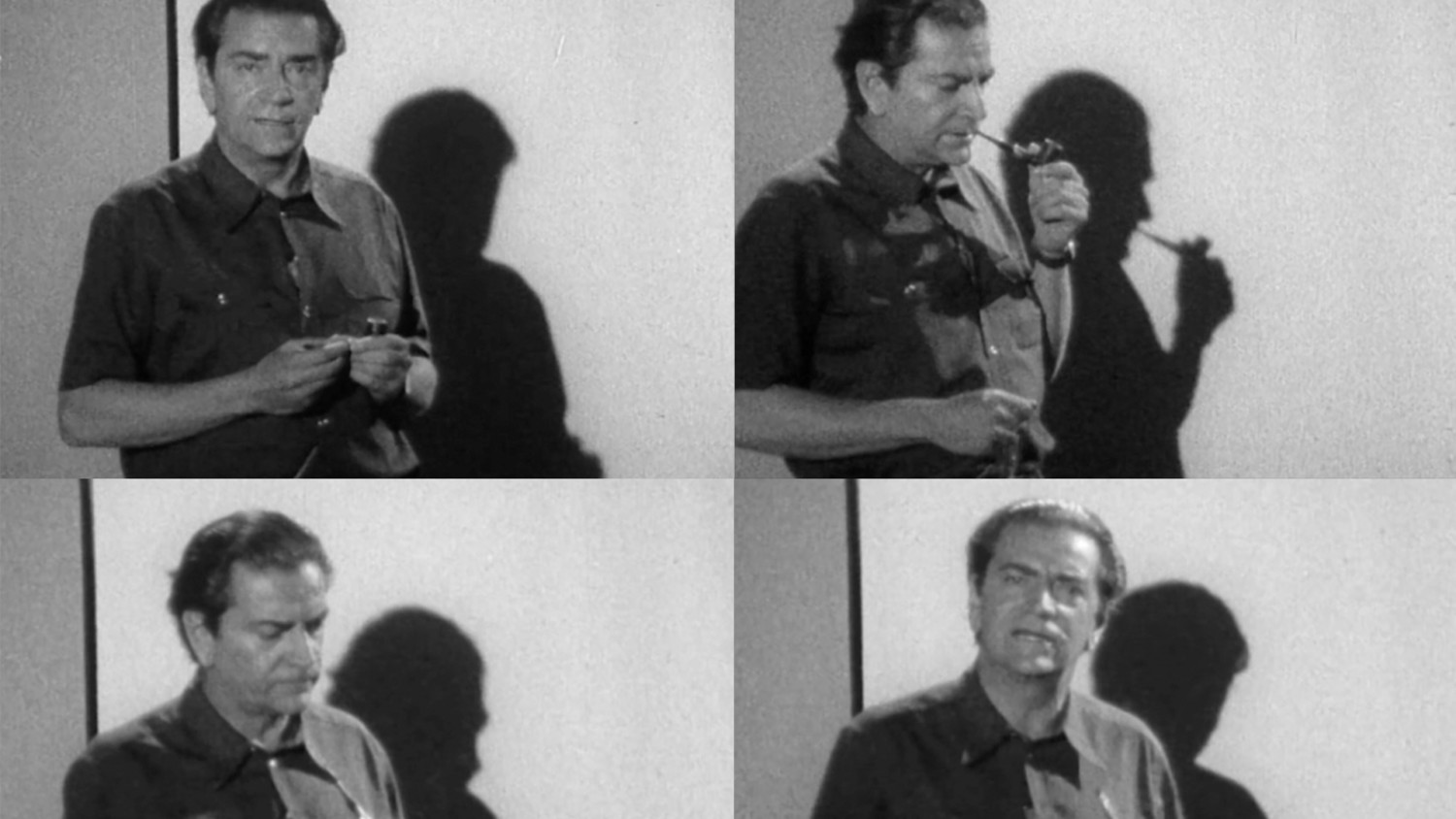
The Italian architect and historian Bruno Zevi was born in Rome in 1918 and died in Rome in 2000. He enrolled in the Faculty of Architecture at the University of Rome. Following the racial laws, he left Italy in 1938, going first to the United Kingdom and then to the United States.
During his time in the States, he discovered the work of Frank Lloyd Wright and his organic architecture approach. He graduated from the Graduate School of Design of Harvard University, chaired by Walter Gropius, and directed the “Quaderni Italiani” of the movement “Giustizia e Libertà” (1933-1944). He discovered Frank Lloyd Wright, whose preaching in favour of organic architecture will remain a strong supporter of life. Returning to Europe in 1943, he participated in the anti-fascist struggle in the ranks of the Action Party. In 1944 he promoted the Association for Organic Architecture (APAO) and the following year he founded the magazine “Metron”. From 1945 until his death in 2000 he was editor of his own maganizne L’architettura. Cronache e storia.
19545 Zevi published Verso un’architettura organica – Towards an organic architecture. The titles suggests it is a response to Le Corbusiers book ‘Vers une architecture’ published 1923.
Following the second work war Zevi was keen to modernise the field of architectural academia in Italy with fresh ideas.
In 1945, Bruno Zevi became Professor of Architectural History at the University of Venice. Later, he was a Professor at the University of Rome, and became a member of the International Academy of Architecture in Sofia, Bulgaria.
The Modern Language of Architecture, published 1978 became one of his most significant publications.
Following his work in Towards an Organic Architecture, Zevi sets finally sets his seven principles he bases his teaching on. This is clearly breaking with a much more formal set of rules promoted by Le Corbusier in his Five Points (1926) or the approach by Mies van der Rohe. The principles are in stark contrast to the predominant teaching philosophy at the time promoted by ideas from the Beaux Art school. Instead of a focus on classical order, the rules of proportion, ideas of beauty and symmetry, Zevi sets out a different framework. He promotes free interpretations, a design process that celebrates the differences and dissonances. The architecture is seen as an integrated part of the surrounding landscape and the context it is set in. The focus is on a multilayered and -dimensional vision of architecture where a playful approach to design and a union of architecture and engineering pavs the way to a diverse expression in architecture. The spaces resulting from this approach embrace the use as their core function.
Architecture is seen at the forefront of innovation and not as the result of backwards-looking reflective processes.
Selected publications:
-Bruno Zevi, Verso un’architettura organica, Giulio Einaudi editore, Torino 1945 (English translation, Towards an Organic Architecture, Faber & Faber, London 1950)
-Bruno Zevi, Saper vedere l’architettura, Giulio Einaudi editore, Torino 1948 (English translation, Architecture as Space. How to look at Architecture, Horizon Press, New York 1957; Da Capo Press, New York 1993)
-Bruno Zevi, Storia dell’architettura moderna, Giulio Einaudi editore, Torino 1950 e 1975
-Bruno Zevi, Architecture as Space: How to Look at Architecture, Horizon Press, New York 1957
-Bruno Zevi, Spazi dell’architettura moderna, Giulio Einaudi editore, Torino 1973
-Bruno Zevi, Cronache di architettura (volumi I-XXIV, saggi 1-1276), Editori Laterza, Roma – Bari, seconda edizione 1978
-Bruno Zevi, Editoriali di architettura (Architetti e linguggio, Crtici e liguistica, Paesaggi e citta, Avanguardia e restaurazione, Design come ragione civile, Not quite architecture), Giulio Einaudi editore, Torino 1979
-Bruno Zevi, Michelangiolo architetto, edited with P. Portoghesi, Giulio Einaudi editore, Torino 1964
-Bruno Zevi, Erich Mendelsohn Opera Completa, Etas Kompass, Milano 1970; Testo & Immagine, Torino 1997 (English translation, Erich Mendelsohn – The Complete Works, Birkhäuser Verlag, Berlin, 1999)
Guido Luca: Bruno Zevi on Le Corbusier: another way to an “organic architecture.


In the 1960’s and 70’s, when he was at the height of his fame, the Italian film director Federico Fellini (1920-1993) often spend his Summer in his holiday villa in Fregene, on the coast near Rome to escape the bustle and commotion of the city.
Over time others came as well: his wife, the actress Giulietta Masina, the filmmaker and writer Pier Paolo Pasolini; the novelist Alberto Moravia; and a dashing actor named Marcello Mastroianni, to name a few. In this golden age, Fregene, once a simple fishing village, became an oasis for Italian intellectuals and Rome’s fashionable Via Veneto crowd.
Photos of the time show Fregene with celebrities such as Sopia Loren and Anthony Quinn.

Fellini directed the film Lo Sceicco Bianco – The White Sheik in 1952. The film is in parts filmed in Fregene very close to the site of the Casa Sperimentale. In the film the main character can bee seen suspended on a swing in the canopies of the local pine trees.

This is one of the first images we took of the Casa Sperimentale during our first visit in 2015. At the time the building was largely open. Very little of the building had been vandalised or covered in graffiti.
Over the last couple of years, we have managed to uncover and collect fragments of the diverse history of the Casa Sperimentale. We are still at the beginning of our journey to discover the many (hi)stories behind this amazing building.
Located in a pine grove on the fringes of Fregene, a seaside town near Rome now directly under the flightpath of Rome Fiumicino Airport, lies the Casa Sperimentale, also known as the Casa Albero or ‘the Treehouse’. Construction started in 1968 led by a family of Italian architects, Giuseppe Perugini (1914–1995), his wife Uga de Plaisant (1917–2004) and their son Raynaldo Perugini (1950–). Giuseppe Perugini was a significant figure in the architecture of post-World War II Italy. Very early on in his career, he collaborated with fellow architect Mario Fiorentino and artist Mirko Basaldella on the Monument of Fosse Ardeatine in Rome. From that time onwards, he spent the majority of his career teaching architectural composition at Rome Sapienza University.
Together with the architectural historian Bruno Zevi, Giuseppe Perugini was one of the founders of the Association of Organic Architecture (APAO). In trying to develop a new kind of open and democratic architecture, Zevi defined a series of seven architectural principles. In contrast to Le Corbusier’s ‘five points of architecture’, in which he defined which architectural elements should be integral to his approach, Zevi’s rules didn’t provide the same clear design advice, they didn’t define a specific way to design or build a new modern architecture. The rules described an organic approach towards an architecture that could be interpreted in many formalistically different ways.
Right from the start the Casa Sperimentale had been conceived as an experiment, a way to test out ideas of collective design, a non-compositional arrangement, and concepts of breaking up traditional spatial arrangements. Perugini’s process was inherently multidisciplinary, rooted in academia and architectural theory (composition). Amongst other fields he touched upon architectural history through his studies of Borromini’s work, early computing through his interests in cybernetic research, urban design through his competition proposals, and tectonic processes through the building of the Casa Sperimentale.
These varied disciplines helped to define a context of his practice, but the practice itself was further shaped by the sociopolitical activity of Italy post World War II, developments in Architecture, and the movements of key individuals contributing to Perugini’s approaches in this period.
All of these fields frame a diverse body of interests, connected through Perugini himself as common denominator. Each of these interests introduces its own line of study, inspiring new and more appropriate research methodologies in turn. Perugini’s interpretation of Borromini took place through a lens of geometric proportion—addressed through drawing research. His interpretations of cybernetic research were theoretical but addressed through written research and expressed in the principles of variation in his Architecture. Construction was explored through his experimentation with new tectonics, new ways of making, and new forms of connection, embodied in the materiality of the Casa Sperimentale. Each subject connects to its own research matter, and each is situated in a primary medium—drawings, documents, tectonics, and historical record. As such each medium reflects a different facet of context.
The building is an important piece of architecture in post war Italy. Still mostly overlooked by the architectural community, its obscure history is only known through a series of surviving fragments. The building it now is in a very fragile state, having been abandoned in 2004 and subject to intermittent vandalism since, it might soon pass beyond a point of recovery.
The Casa Sperimentale can be considered as a first step in a series of projects by the Perugini family exploring ideas of prefabrication and open-ended design processes, leading to a series of projects that introduced computational calculations and early cybernetic approaches into the field of architecture in the mid 1960’s. It draws reference from studies of the Baroque architectures of Francesco Borromini, especially in Perugini’s own research work on San Carlo alle Quattro Fontane and Santa Maria dei Sette Dolori in Rome. The project may be read as a response to Bruno Zevi and Perugini’s definition of an ‘organic architectural approach’, promoted in the APAO (Association of Organic Architecture).
The house which was once at the centre of an intellectual and bohemian community living in Fregene during the summers in the early 1960’s to the late 1970’s has, since its abandonment, been rediscovered by the public via social media as the perfect Instagram geo-taggable location. More critically it is used by urban subcultures as a perfect canvas for graffiti and an exercise ground for free-running – urban parkour.
The Casa Sperimentale is often categorised as a Brutalist building. However, despite its concrete form it isn’t born out of a brutalist mindset. It is rather the result of an alternative approach – a refined, considered, organic, democratic and most of all human response to architectural design.
The project consists of three independent buildings:
the Casa Sperimentale—the main house,
the Sphere—an experiment to design a self-contained living space set in a five-meter concrete sphere and,
the Guest Houses—a set of separate buildings placed towards the rear of the site.
The project, the collection of buildings, is surrounded by a curved concrete perimeter Fence.
In the late 1960’s and early 1970’s the Perugini family experimented with novel construction techniques and an unorthodox design method to create an extraordinary elevated house, a concrete treehouse. The story that led to the creation of the building is unique, it links into the history of early architectural computing, and connects it with an obsession for the 17th century Baroque architecture of Francesco Borromini. As a result, the architecture plays with numbers, structure and light, and sat at the heart of a movement which explored ‘organic’ human-scale architecture.
The design of the Casa Sperimentale follows the idea of a suspended object inhabiting an elevated position amongst the pine grove, echoing the forest structure—an irregular grid of tree trunk-like columns and overarching concrete branches supports an architectural canopy overhead. Several ‘trees’ merge together to create a seemingly solid body, whilst leaving narrow clearings through which the sky can be glimpsed from the pool beneath the building. In forests this aligns with a phenomenon known as ‘canopy shyness’, where trees permit a consistent narrow gap between themselves, the exact reason for which is still hypothesised.
Breaking with the traditional arrangement of floors, ceilings, and supporting walls, the house sits above a body of water—the pool—reflecting the underside of the building and creating a defined void in-between. This is repeated within the house by carefully placing openings and slits in the floors and ceilings—breaking the traditional structure of the house into elements. This new space between the elements becomes an open void without defined boundaries.
The design and construction were organic processes—starting as sketches, driven by intuition, most final design decisions were made ad-hoc on site. Whereas the design of the superstructure was developed rapidly, the placing and the nature of the enclosing walls in the grid were much debated during the building process. Perugini explored ideas of modular living in the 1967 INARCH-FINSIDER competition. These ideas were developed further in the Casa Sperimentale where they significantly informed and transformed the design.
The superstructure consists of three main concrete frames from which further building elements are suspended. Each of these modular elements are further divided into individual segments separated by a slither of glass and supported at the centre through a bespoke steel coupling. The horizontal and vertical elements are independently supported leaving the surrounding walls as non-load bearing interchangeable infill elements.
Giuseppe envisioned the house as a series of pure concrete boxes. But Uga preferred a much more perforated skin throughout, allowing visual connections between the house, the surrounding landscape, and the tree canopies. After much negotiation, individual elements were cast and placed on the concrete floor slabs following a set of strict geometric rules. Through a composition of hollow concrete framed panels and open concrete window frames, on a 500mm grid, Perugini defined a lively undulating wall elevation.
Some elements have precast markings of letters and numbers, this alludes to the exchangeable interchangeable character of the individual building blocks, and an inherent set of assembly instructions, whilst referring to the manufacturing processes behind their formation. Finally, the openings were finished with bespoke metal window frames following a similar geometric system of squares.
In striking contrast to this grid geometry are two cantilevered elliptical spheres as bathrooms. These were cast in two sections as hemispheres in the sand on-site and are separated from one another by a narrow glass strip. The bathrooms are entered through circular centrally pivoting doors with translucent infills.
The Sphere, an independent structure for a self-contained micro-house, was originally intended to be fitted out with a suspended bathroom and a circular kitchen block, however, it was used by the family in an ad-hoc state as a kitchen. It is sited on the forest floor next to the main house and its elements were also cast from a hemispherical mould in the sand. Taking reference from the Pantheon the upper hemisphere has a small oculus opening at the azimuth.
The form of the Guest House consists of three rooms and has been built in a more traditional way with concrete blockwork. The entrance doors were designed as rotating drum segments opening outwards. Each room has large portholes as windows connecting them with the site and back to the main house.
Their son, Raynaldo, refers to the house as the ‘unfinishable endless house’. Being conceived as an almost Lego like structure, all wall elements are simply bolted together. In this way, they can be removed and reconfigured to create different arrangements of spaces, enabling different connections between the space and the surrounding site. A speculative drawing by the architects shows how the structure could extend over the entire site to create an endless meandering concrete treehouse complex.
After the deaths of Giuseppe Perugini, and Uga de Plaissant, in 1998 and 2004 respectively, the house was abandoned. After some years of relative safety, an increased exposure on social media platforms—first Flickr then Instagram—led to more break-ins and illegal visits by the interested public to the site. Whereas in the beginning Angelo Bellotto attempted to halt this by opening up the house to these influx of people, recently, over the previous few years he has been unable to look after the house due to illness. As such, it has become an Instagram location, a spot for urban freerunning and the set for illegally shot music videos. All this has taken a toll on the building—windows smashed, doors broken, and concrete eroded.